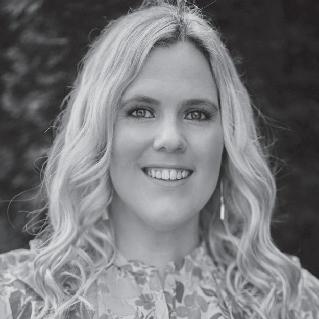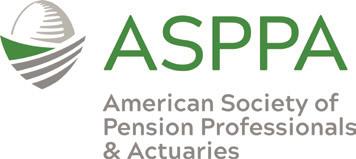POOLED POTENTIAL
PEPs At a Crossroad
Can they overcome their initial challenges to potentially reshape the future of the retirement plan landscape?

DISPEL SOCIAL SECURITY MYTHS
START-UP PLAN DESIGN RECOMMENDATIONS
MAKE WAVES AT ASPPA ANNUAL 2025


Can they overcome their initial challenges to potentially reshape the future of the retirement plan landscape?

DISPEL SOCIAL SECURITY MYTHS
START-UP PLAN DESIGN RECOMMENDATIONS
MAKE WAVES AT ASPPA ANNUAL 2025


18|POOLED EMPLOYER PLAN POTENTIAL
Can they overcome their initial challenges to potentially reshape the future of the retirement plan landscape?
By Travis Jack
26|HOW TO DISPEL SOCIAL SECURITY MYTHS
How does an employer, plan sponsor, or retirement plan professional go about dispelling the myths concerning Social Security?
By John Iekel
32|PLAN DESIGN RECOMMENDATIONS FOR START-UPS
We need to embrace small businesses that are taking this great step.
By Chad Johansen
08|FROM THE PRESIDENT AI Is Here—Now What? By JJ McKinney
11|NEWLY AND RECENTLY CREDENTIALED MEMBERS
48|INSIDE ASPPA Making Waves in Retirement By Julie Altig and Steve Riodan
06|LETTER FROM THE EDITOR How to Win Friends and Influence People By Joey Santos-Jones
10|REGULATORY / LEGISLATIVE UPDATE Signed, Sealed, Delivered By Brian H. Graff

12|ACTUARIAL / DB DB Ins and Outs — In-Service Withdrawals By Jon Murello 14|COMPLIANCE / ADMINISTRATION
Mega Back Door Roths May Not Work By Betsy Schaaf
60|GOVERNMENT AFFAIRS UPDATE What’s Your New (Fiscal) Year’s Resolution? By Josh Oppenheimer
AI Is Knocking at Your Door— Will Your Firm Let It In? By Shannon Edwards and Theresa Conti
52|MARKETING
How to Maximize Your LinkedIn Presence in Three Steps By Theresa Conti and Chad Johnson
56|SUCCESS STORIES
Retirement Plans: Have Some Class By John Iekel







Julie Altig, QKA, QPC, CPC is Owner/ Partner with Atlantic Pension Services, Inc.
Katie Boyer-Maloy is a trained communications specialist with a willingness to go above and beyond for her clients. Boyer-Maloy is a member of the Plan Consultant Committee.
Theresa Conti, QKA, APR, ERPA, CBFA has been involved in the retirement plan industry for more than 35 years, she started her firm Sunwest Pensions in 1998 and sold it to July Business Services in 2023.
Shannon M. Edwards, ERPA, QPA, QKC, QKA, is the President of TriStar Pension Consulting. She is a member of the ASPPA Leadership Council and the Plan Consultant Committee.
Kevin Gaston, CPC, QPA, QKC, QKA, TGPC is Head of Strategic Retirement Consulting with Vestwell.




John Iekel has served as the editor of ASPPA Connect and the NTSA Advisor, electronic newsletters that serve ASPPA and the NTSA, since those newsletters were inaugurated in 2014; he also writes content for them. John also provides editorial assistance for the newsletter serving ASEA. He has provided content concerning retirement and other employee benefits, as well as tax policy, through a variety of platforms throughout his career.
Travis P. Jack is the Managing Member of Metz & Associates, PLLC and oversees the employee benefit plan audit practice. Jack is a member of the Plan Consultant Committee.
Chad Johansen is a Partner and Director of Retirement Plan Sales with Plan Design Consultants, Inc.
Jon Murello, FSA, EA, MAAA, CERA is the Lead Actuary with Pittsburgh, Penn.-based Dunbar, Bender & Zapf.
Betsy Schaaf, APM is an ERISA Attorney with Definiti, LLC in the Cincinnati area with more than 25 years in the retirement industry. She has worked with TPA firms, bundled providers and as a consultant. She has worked extensively in document drafting and EPCRS.
Plan Consultant is Published by

EDITOR IN CHIEF
Brian H. Graff, Esq., APM
PLAN CONSULTANT COMMITTEE
Mary Patch, QKA, CPFA, Co-chair; David J. Witz, Co-chair; Lee Bachu; R.L. “Dick” Billings, CPC, ERPA; Gary D. Blachman; Katie Boyer-Maloy; Jason D. Brown; Linda Chadbourne, QKA; Theresa Conti; Megan Crawford; Sara DeFilippo, E.A.; Shannon Edwards, ERPA; John A. Feldt, CPC, QPA; Emily Halbach; Travis Jack; Chad Johansen; Jim Racine; Olivia Schwartz; Rickie Taylor
EDITOR
John Sullivan jsullivan@usaretirement.org
SENIOR WRITERS
Ted Godbout, John Iekel
ADVERTISING SALES
Tashawna Rodwell trodwell@usaretirement.org
TECHNICAL REVIEW BOARD
Rose Bethel-Chacko, CPC, QPA, QKA; Marianna Christofil; Michael CohenGreenberg ; Sheri Fitts; Drew Forgrave, MSPA; Grant Halvorsen, CPC, QPA, QKA; Jennifer Lancelot, CPC, QPA, QKA; Robert Richter, APM
COVER Anton Watman / Shutterstock.com
2025 ASPPA OFFICERS
PRESIDENT
JJ McKinney IV, CPC, QPA, QKA
PRESIDENT-ELECT
Shannon M. Edwards, ERPA, QPA, QKC, QKA
VICE PRESIDENT
Manny Marques, CPC. QPA, QPFC, AIF®
IMMEDIATE PAST PRESIDENT
Amanda Iverson, APM
Plan Consultant is published quarterly by the American Society of Pension Professionals & Actuaries, 4401 N. Fairfax Dr., Ste 600, Arlington, VA 22203. For subscription information, advertising, and customer service contact ASPPA at the address above or 800.308.6714, customerservice@USAretirement.org. Copyright 2025. All rights reserved. This magazine may not be reproduced in whole or in part without written permission of the publisher. Opinions expressed in signed articles are those of the authors and do not necessarily reflect the official policy of ASPPA.

Friday, November 14 12 – 3:00 pm EST

The Trump Administration sent an EBSA official to Paris to deliver remarks on ESG. What followed was a comically blunt assessment that was entirely on brand. By John Sullivan
The Trump Administration brought its unique style of diplomacy to the Organization for Economic Co-operation and Development (OECD) in midSeptember, decrying ESG and claiming, “at its core, it looks a lot like a Marxist march through corporate culture.”
Justin Danhof, Senior Policy Advisor for the Employee Benefits Security Administration (EBSA) for the Department of Labor, delivered the remarks to delegates at the OECD’s inaugural Roundtable on Global Financial Markets in Paris.
After a brief description of ERISA and its requirements, Danhof argued a pension system should be “robust,” and one that “eschews politics and other social purposes.”
“For far too long, special interests and policy organizations have pushed politicized investing, including within pension funds,” Danhof said. “America is not blameless in this folly. Many American businesses, pensions, and prior Administrations have adopted and even advocated for these policies. However, because of our clear standards, America’s adoption of politically motivated investments has been far less than some other OECD members, as evidenced by the low rate of such practices in ERISA-qualified plans.”
He said his ESG remarks were appropriate at the event because the OECD is a “collaborative international body” and because ESG was born two decades prior at a separate international collaborative body, the United Nations.
“ESG, like most three-letter acronyms, is meant to obfuscate, not define. In this sense, the UN did a masterful job in construction,” he said, adding “the “point of a system is what it does. Let me say that again. The point of a system is what it does. And some systems are meant to corrupt.”
Likening ESG to Marxism, he said its aim is the destruction of capitalism.
“While the United Nations officially coined [the term] ESG in 2004, it wasn’t until the last five or six years that it has seemed to be everywhere all the time, threatening to fully corrupt capitalism’s facilitation of excellence.”
He then accused the OECD of a “massive” role in integrating ESG pursuits into the pension systems of its member countries.
“For years, the OECD has been pushing members to politicize their pension systems by integrating ESG factors unmoored from returns,” Danhof said. “One OECD policy details at length how ‘to strengthen ESG investing and finance a climate transition.’ Another one contains extensive ‘guidelines on the integration of ESG factors in the investment and risk management of pension funds.’”
Arguing that “ESG is not just some side-bar political or policy issue,” he said it’s about sovereignty and security as well.
“Authoritarian leaders love when our member nations embrace ESG. Why? Because it lessens your prosperity and makes you less competitive. If America and other OECD member companies hamstring our nations’ capital markets and pension systems with superfluous ESG costs, it only serves to benefit authoritarian regimes that do not engage in such frivolity.”
“The United States is no longer going to support these policies, even tacitly,” Danhof concluded, referring to Paris in noting, “One of the City of Light’s most famous sons once wrote that ‘[t]he greatness of America lies not in being more enlightened than any other nation, but rather in her ability to repair her faults.’ America faulted with ESG. We are now on the mend.’” PC

John Sullivan Editor-in-Chief

DECEMBER 8-9, 2025
Our ability to be nimble, observant, and curious will define how automation and AI transform our industry.
By JJ McKinney
Artificial Intelligence (AI) is the belle of the ball, the talk of the town, top of mind, and hot on the lips of anyone willing to open their mouths about technology and what it has done for me lately.
Automation has propelled the workforce forward in manufacturing, communications, data reconciliation, information gathering and analysis, and the list goes on, with much more to come.
Although not new, think back: AI has truly defeated chess grandmasters worldwide, fictionally began a campaign to destroy humankind in The Terminator, truly learns and responds to our buying behaviors, and fictionally almost started World War III in War Games.
Since the concept first squinted its eyes to the light of the world in the 1950s, AI has advanced and retreated, as most technologies do. When they meet or exceed expectations, investors and supporters pour more into exploration, or when they fall short, our human pocketbooks retreat, waiting for someone else to take the next phase, or potentially allow dormancy for a time.
Currently, we have the ingredients for an automation renaissance and an AI revolution – high stakes and high cash. Investors stand ready and willing to support ideas with the potential to reshape the work environment, from blue-collar to white-collar, from lab coats to OR scrubs, and from mathletes to consultants.
Pick and mix your metaphors, blue ocean meets a purple cow at the yellow wood. In a real sense, AI is a blue ocean of uncontested opportunity, where a traditional company doing business in a traditional way faces the potential purple cow of an innovative product or service, and stands as “two roads diverge in a yellow wood” (Robert Frost’s “The Road Not Taken”), trying to decide which path to take.
The stakes are high; our direction and approach can leave us spinning in mud and paralyzed, with options that inhibit action, slowly and cautiously taking baby steps, implementing one piece at a time, or brakes off, gripping the wheel and navigating bumpy paths of trial and error.
Whether we implement AI and automation is not the question. Where do we need it most? Where do we start? Is our infrastructure ready? How will they improve our current way of doing business? In what ways can we use them in big, hairy, audacious ways to recreate ourselves? These are questions to ask and more. No matter what we each decide or how we answer these questions for ourselves, our providers, allies, competitors, clients, and colleagues are all engaged in the same conversations, which means our personal lives, industry, and world are changing at a pace of drinking from a firehose or laying track in front of the oncoming train.

Commit and engage in the possibilities; stay curious, creative, and cognitively flexible. Watch with eyes wide open and 20/20 peripheral vision. Fascinatingly, if we feel we have made a wrong turn, we do not need to go back to the start to switch course; we can add lanes. Our journey through technological advancement and enhancement is a continuous learning process, taking place in an evolutionary environment as we explore and implement new developments. Our ability to be nimble, observant, and curious will define how automation and AI transform our industry.
ASPPA and the ARA are actively engaged in discovery and implementation to support our members and the future of working Americans through interactive education and resources, and by listening intently to the issues impacting members so we can take action. PC

NAPA and the ARA recently joined several other industry organizations in urging the Department of Labor to quickly issue guidance for fiduciaries to increase access to private market investments in retirement plans. By Brian H. Graff
The American Retirement Association (ARA) and its affiliates support greater retirement plan access to private market investments —believing plan sponsors, acting in their fiduciary capacity while receiving professional advice, know what’s best for their participant demographic.
Not all will find it appropriate to offer private market investments in their retirement plans. Yet, the ARA believes the option should be available to, at the very least, consider doing so.
As part of our efforts, we joined several related industry advocacy organizations in sending a letter to the Department of Labor in early September.
Addressed specifically to Secretary Lori Chavez-DeRemer, it expressed our support for President Trump’s Aug. 7 Private Market Investment Executive Order (EO) and urged the department to issue preliminary guidance quickly to help plan fiduciaries consider including prudent alternative investments in defined contribution plans.
We argued that with the number of public companies declining and private markets now representing more than $30 trillion in assets, participants in DC plans have fewer opportunities to gain exposure to the types of alternative strategies that defined benefit plans, endowments, and other institutional investors have long used to diversify portfolios and enhance long-term outcomes.
While the letter’s signatories strongly support the use of notice-and-comment rulemaking, the letter explained that a full rulemaking process will take a significant amount of time, during which fiduciaries will be left with uncertainty.
“Without timely guidance, fiduciaries face a chilling effect that hinders innovation and leaves participants with narrower diversification and market participation opportunities than are available to other sophisticated investors,” the letter read.
Importantly, acting rapidly would address the EO’s directive to curb unnecessary litigation, the letter further advised.
“Ambiguity in fiduciary duties has historically created an environment ripe for costly and burdensome lawsuits. By issuing timely guidance, the [d]epartment can reduce the legal uncertainty that fosters litigation, thereby empowering fiduciaries to exercise their best judgment with regard to funds that include alternative assets.”
To mitigate this uncertainty and comply with the EO’s directive, the DOL could issue sub-regulatory guidance that includes, for example, a Compliance Assistance Release, Field Assistance Bulletin, Tip Sheet, or Interpretive Bulletin, the letter further suggested.
“Interim guidance would not displace the importance of rulemaking but would serve as an essential bridge, enabling fiduciaries and product innovators to begin adapting and developing participant-ready solutions more quickly,” it added.

“By combining timely subregulatory guidance with a commitment to formal rulemaking, the Department can provide fiduciaries with the confidence needed to evaluate alternative investments today and create a lasting framework for the future,” the letter concluded.
I wish to reiterate that the ARA does not take a position on whether or not plan sponsors should include private market investment offerings in their retirement plans, only that they should have the option available to them if, acting in a fiduciary capacity and in concert with an advisor, they choose to do so.
As always, we will continue to provide updates and explanations as events transpire. PC
CPC™
Ryan Brown
Mary Harte
Anthony Kranz
Steven Matthews
James Passarelli
Richard Strouse
QPA™
David Fehlman
Bernard Gmitter
QKC®
Stephanie Anthony
Natalia Araya
Bryan Arce Vargas
Justin Baird
Mohammed Ben Youness
Maria Berrick
Jill Casey
Alexandra Chang
John Crews
Jimson Cuenta
Blake Curdy
Michelle De Sutter
Brenna Deland
Vanessa Diiorio
Kevin Drea
Sarah DuRee
Kim Gielczyk
Elia Gomez Guillen
Ann Gorman
Sandra Hagemeister
Samuel Haskins
Katherine Huckabay
Xinrong Li
Ellis Miles
Albin Murillo
Misty Partello
Greg Thompson
Minhui Weng
Lydia Allen
Tim Appleby
Heather Baron
Rachel Beauchamp
Jarrod Besl
Dustin Boone
Debbie Bosse
Kelsey Bovy
Joshua Broyles
Erin Bubrick
William Cannon
Christina Carnrite
Tanner Cawthon
Kishor Chand
Valentin Chavarria
Michael Cibiniak
Daniel Civis
Stephanie Coburn
Christopher Contrera
Natalie Crawford
Andrew Crim
Jarod Eassa
Andrew Eckelberger
Jiah Elliotte
William Ellis
Yenifer María Esquivel
Vargas
Andrea Fontanilla-Taoy
Lisa Gotberg
Cayton Green
Lisa Haberman
Emily Hanson
Tamara Hayas
Cindy Heinz
Melissa Himel
Shaikh Pran Priyo Hossain
Jessica Hyten
Lul Ibrahim
Shelby Jury
Cortany Kersey
Beverly Klepper
Cammi Knapp
Tom Lau
Sophia Lee
Xinrong Li
Christian Llerena
Meaghan Macario
Michelle Maradie
Amanda Martinez
Angelo Mastroviti
Phillip Melendez
Rebecca Melnick
Tessa Milam
Shelby Miller
Stacey Morgan
Albin Murillo
Patrick Murphy
Bryan Nagode
Mayeen Naomee
Rama Naradasu
Linda Nguyen
Leigh Parker-Walls
Tara Penland
Valerie Penrod
Burton Price III
Mary Beth Purvine
Isabella Read
Evan Richard
Oscar Luis Rivas
Robert Rothenberg
Brad Scherer
Wayne Scott
Aaron Sealey
Spencer Shay
Alexander Sherman
Tara Squibb
Katherine Starr
Brittani Stephenson
Gregory Tedone
Melissa Tempest
Alexandru Tetici
David Thorogood
Holly Turner
Katharine Turner
Mark Tyler
Daniel Ulate
Susan Utler
Janice Vo
Alexander Ware
Matthew Welborn
Minhui Weng
Danielle White
Seth Williams
Amber Wolf
Steven Yangv
Why can’t I just take out what I want? It’s my money! By Jon Murello
Defined benefit plans and cash balance plans have become an excellent way for plan sponsors to provide retirement benefits for the owner of a company and their employees. However, if an owner is not properly advised, they may think they can ‘withdraw’ funds from the plan’s assets without implication.
In fact, “withdrawing” funds from a defined benefit plan is technically known as an in-service distribution. When an owner takes an in-service distribution from their defined benefit plan, they need to be aware of the various implications of doing so.
The details of in-service distributions from defined benefit plans differ significantly from those of defined contribution plans. For defined benefit plans, in-service distributions cannot be taken before age 59 ½.
In a defined benefit plan, participants accrue a monthly benefit limited by the Internal Revenue Code (IRC) 415. Specifically, an individual’s IRC 415 limited monthly benefit is calculated using the applicable dollar and compensation limits in the form of a straight life annuity.
Without getting into the actuarial details, when an individual takes an in-service distribution from a defined benefit plan, the distribution needs to be converted to an equivalent monthly benefit, and the participant’s 415 limited monthly benefit must be offset by the amount.
As the IRC 415 monthly benefit is used to calculate a participant’s IRC 415 maximum lump sum, correctly reflecting an in-service distribution is vital to the proper administration of the defined benefit plan.
The actual process of converting the in-service distribution to a monthly straight life annuity that offsets the 415 monthly limit is complex. Limited formal rules are available on the subject, so guidance must be taken from regulations, prior law cases, each plan’s specific plan document, and IRC 415 limit calculation requirements.
When an in-service distribution is taken, this effectively creates at least two annuity starting dates (the date of the in-service distribution and the distribution related to eventual plan termination). This makes what is known as multiple annuity starting dates (MASDs). The main condition that must be met with MASDs is that IRC Section 415 must be satisfied at all annuity starting dates.
By taking an in-service distribution, the owner is reducing the amount they can receive from the plan when it eventually terminates. As a rough approximation, for a participant with maximum service and compensation, under current regulations, the IRC 415 maximum lump sum would be about $3.4 million.
This figure would be reduced by any in-service distributions taken from the plan. In-service distributions themselves are an integral aspect of various defined benefit plan situations that often go overlooked.
Some Defined Benefit plans have been around for a long time and adopted in a very complex manner. Often, these plans utilized an outdated benefit formula, covered participants the plan sponsor did not want to cover, or provided life insurance that did not meet the plan sponsor’s needs.
In this instance, a plan sponsor may want to terminate the complex plan, pay out participants, and adopt a new cash balance plan. When this happens, the IRC 415 monthly limits in the newly adopted plan must be offset by the lump sum distributions of the old plan (after conversion from the lump sum to a monthly annuity).
When this calculation takes place, the owner may have little or no room under IRC Section 415 to accrue a benefit in the new plan. This critical requirement can be surprising to an owner, and it is important that they do not believe they can accrue another full IRC 415 monthly benefit in the newly adopted plan.
Often, a defined benefit plan may be overfunded. Excess assets are a complex situation, but in general, excess assets reverted to an employer at plan termination are subject to a 50% Excise Tax and then subject to corporate and shareholder taxes. A plan sponsor may think that by taking in-service distributions, they can help reduce the plan’s excess asset situation.

“IT IS ESSENTIAL TO INFORM THE OWNER THAT WHEN A QDRO BENEFIT IS PAID OUT, THEY SIMPLY CANNOT ‘REPLACE’ THE DISTRIBUTION PAID TO THE EX-SPOUSE IN THE PLAN, AS DOING SO WOULD LIKELY OVERFUND THE PLAN AND CREATE AN EXCESS ASSET SITUATION.”
However, what is happening is that while they are reducing a plan’s asset value, they are also reducing the plan’s overall liability by a roughly equivalent amount.
Further, if the plan is a traditional defined benefit plan where the liabilities are subject to IRC Section 417(e) interest rates, the plan sponsor is preventing the plan from reducing its excess asset situation. This is because the plan can no longer take advantage of the interest rate risk from a larger liability, which would have reduced the plan’s excess assets. A plan sponsor who believes in-service distributions can help with their excess asset situation has received poor advice.
An owner who sponsors a defined benefit plan and is going through a divorce can create a delicate situation. Not only are they going through an intense personal ordeal, but their finances are in the process of being split with their spouse. There may be a QDRO drafted to provide a portion of their benefit from the defined benefit plan to the ex-spouse. If the ex-spouse takes a lump sum of their benefit, this is technically an in-service distribution of the owner’s benefit.
The owner may think that their IRC 415 monthly benefit is not affected by the ex-spouse’s payout from the QDRO, but it is, in fact, affected. It is essential to inform the owner that when a QDRO benefit is paid out, they simply cannot ‘replace’ the distribution paid to the ex-spouse in the plan, as doing so would likely overfund the plan and create an excess asset situation.
Withdrawals cannot be simply taken from a defined benefit plan by an individual owner. Rather, these withdrawals are in-service distributions that need to be tracked to ensure that IRC Section 415 is satisfied at all annuity starting dates.
In-service distributions can complicate plan terminations, excess asset situations, starting a new plan when terminating an existing plan, or when an owner is going through divorce proceedings. The plan’s actuary must provide sound guidance to the plan sponsor when an in-service distribution situation occurs, and the specific implications for the plan sponsor and the plan itself. PC
Understanding the potential for enhanced retirement savings. By Betsy Schaaf
A Mega Back Door Roth transaction is a strategic financial maneuver that enables individuals to maximize their retirement savings by leveraging the unique features of a Roth IRA.This strategy is particularly beneficial for high-income earners who may be restricted from contributing directly to a Roth IRA due to income limitations.
To fully grasp the concept of a Mega Back Door Roth, it is essential to understand the basic principles behind Roth IRAs and the income limitations imposed on them. Unlike traditional IRAs, Roth IRAs offer tax-free growth and tax-free withdrawals in retirement, making them an attractive option for long-term savings.
However, the IRS imposes income limits on direct contributions to Roth IRAs, which often exclude individuals with higher incomes. Before discussing potential pitfalls, we must first understand the overarching strategy.
For 2025, the maximum annual contribution to a Roth IRA is $6,500, or $7,500 for individuals aged 50 and above. These contributions are subject to income phase-out ranges, which start at $138,000 for single filers and $218,000 for married couples filing jointly. Once these limits are exceeded, direct contributions to a Roth IRA are no longer allowed.
The Mega Back Door Roth strategy utilizes the contribution limits of a 401(k) plan to channel funds into a Roth IRA. The following is a step-by-step breakdown of how this transaction works:
Firstly, the individual maximizes their traditional 401(k) contributions. For 2025, the limit for elective deferral contributions is $22,500, with an additional $7,500 catch-up contribution for those aged 50 and above.
Next, the individual makes after-tax contributions to their 401(k). Some 401(k) plans allow after-tax contributions beyond the pre-tax and Roth 401(k) limits, but many do not. This is a critical component of the strategy. For 2025, the total annual contribution limit for 401(k) plans, including employer contributions, is $66,000, or $73,500 for those
aged 50 and above. This means that after maximizing pre-tax and Roth contributions, the remaining amount can be contributed on an after-tax basis. It should be noted that these after-tax contributions are not considered Roth deferrals.
3. In-Plan Roth Conversion
Once the after-tax contributions have been made, the individual can opt for an in-plan Roth conversion. This process involves converting the after-tax contributions into a Roth 401(k) within the same plan. The converted amount will grow tax-free and can eventually be withdrawn tax-free in retirement. Not all plans contain a Roth In-Plan conversion option.
4. Rolling Over to a Roth IRA
Alternatively, rather than converting within the 401(k) plan, the individual can choose to roll over the after-tax contributions directly into a Roth IRA. This rollover can occur either through direct transfer or via a distribution followed by a rollover within 60 days. The rolled-over amount will then benefit from the taxfree growth and tax-free withdrawals of a Roth IRA. This will suffice if a plan does not permit in-plan Roth conversions.
BENEFITS OF THE MEGA BACK DOOR ROTH
The Mega Back Door Roth strategy offers several advantages for those looking to maximize their retirement savings:
1. Higher Contribution Limits
By utilizing after-tax 401(k) contributions, individuals can potentially contribute significantly more to their retirement savings compared to traditional IRA and 401(k) limits.
2. Tax-Free Growth
The converted amounts grow tax-free within the Roth account, allowing for greater accumulation of wealth over time.
3. Tax-Free Withdrawals
Qualified withdrawals from a Roth IRA are tax-free, providing a significant advantage in retirement when compared to taxable withdrawals from traditional IRAs or 401(k)s.
4. No Required Minimum Distributions
Because Roth IRAs do not require minimum distributions during the account holder’s lifetime, the funds can continue growing tax-free for heirs.

While the Mega Back Door Roth strategy can be highly advantageous, there are some considerations and potential drawbacks to keep in mind:
Not all 401(k) plans permit after-tax contributions or in-plan Roth conversions. It’s essential to verify with the Plan Administrator whether these options are available.
Although the Mega Back Door Roth strategy can work very well in the right scenario, it is critical to remember that traditional after-tax contributions are required to be included in the Plan’s ACP test. The test frequently fails if the demographics include NHCEs, since frequently only the higher-paid employees tend to make this type of contribution, at least in any appreciable amount. With all the press this strategy receives, the testing of the after-tax contributions is seldom mentioned.
In the author’s opinion, this strategy works best in owneronly plans.
The conversion of after-tax contributions to a Roth account may have tax implications, particularly if the contributions have accrued earnings. It’s crucial to consult with a tax advisor to understand the potential tax consequences.
Executing a Mega Back Door Roth transaction involves multiple steps and requires careful planning and coordination. It may be beneficial to work with a financial advisor to ensure the process is executed correctly.
A Mega Back Door Roth transaction can be a powerful tool for maximizing retirement savings, especially for high-income earners who are otherwise restricted from contributing directly to a Roth IRA.
By leveraging the contribution limits of a 401(k) plan and executing a strategic conversion, individuals can benefit from tax-free growth and tax-free withdrawals in retirement.
However, it’s essential to consider plan restrictions, nondiscrimination concerns, tax implications, and the complexity of the process before proceeding. This strategy is most successful with careful planning and professional guidance; the Mega Back Door Roth strategy has the potential to enhance one’s retirement savings and financial future significantly.
It should be noted that the IRS has informally indicated that they are not particularly fond of this strategy; however, until the Tax Code and its attendant regulations are changed, this should continue to be a valuable strategy for the appropriate client. PC
For plan practitioners, there are a few things to be aware of as we consult with plan sponsors. By Kevin O. Gaston
Section 103 of SECURE 2.0 contains what may be the longest amount of code of any SECURE 2.0 provision.
Weighing in at a hefty 20 pages (of the ~350 total), the section reads far less like a modification to retirement, and more like a dive into sections of tax code deep enough to mandate numerous searches to the venerable Cornell Law School Legal Information Institute.
Explaining the nuance and minutiae of the tax code changes would present two challenges.
First, as the match is an evolution of the Saver’s Credit, many of you fine readers may already be familiar with the mechanics; the match changes the method more than the actual function of
the existing code. Second—in the interest of a readable article, I offer answers to three questions:
1. What are the high notes of the Saver’s Match?
2. What do I need to know as an administrator of qualified plans?
3. What does it mean for savers?
WHAT ARE THE HIGH NOTES OF THE SAVER’S MATCH?
The OG Saver’s Credit was established with EGTRRA in 2001 and became effective for the year 2002. PPA in 2006 made the law permanent before it was set to expire. The amount has been the same over this entire time – a credit of up to 50% of

your first $2,000 in retirement contributions, provided you filed for it and were under certain income limits.
The reality is that the Saver’s Credit was and remains heavily underutilized for several reasons. Since the credit is nonrefundable, if you didn’t have a tax obligation, then the credit could not be applied for a refund, nor moved to another tax year. Given that nearly 66% of tax filers receive a refund, which is inversely proportional to income, it’s no surprise that earning the credit is a challenge.
The match hopes to provide the same formula instead, but make a contribution to the saver’s retirement vehicle of choice (and I do mean ‘of choice’ – 457, 408, 403, 401, or IRA, all count) after they file their taxes.
The match is one of the later provisions to become active under SECURE 2.0, with a start date slated for January 1, 2027. This means the actual funds are not payable until after taxes are filed for 2027. If you are a procrastinator, know that this is a “sometime in 2028” problem, versus that pesky Roth Catchup coming to a plan near you in just a few months.
If you are reading this article, you may think we are discussing a match. Right? It’s up there in the title and everything. As an administrator, forget I ever said match. Pretend it is a new, odd, not-at-all matchy type of source.
One sunny day in 2028, as you sip your chosen morning beverage, an ACH is going to show up in a plan. It will be for an amount of $1,000 or below. And in a change of pace, it is coming from the US Treasury. When it arrives, you account for it, but how do you treat it?
1. It is not a match in the 401(m), ACP way we usually think of a match.
2. It IS considered a participant contribution, but;
3. It’s not counted against any contribution limit, and;
4. It’s not counted against the catch-up limit, and;
5. It’s disregarded for 401(a)(4), 401(k)(4), and (big inhale) 401(k)(11)(B)(i)(III)
a. If that last one seems entirely foreign, it is because it is the rules for SIMPLE K, the thousand island dressing of Safe Harbor
6. Since it can be earned by saving into any retirement plan and then sent to any retirement plan, the check may not align with what they have saved in the plan you administer. Since it is on the saver to qualify, it is not incumbent on you to validate.
Two items remain for the administrator to consider:
TIMING OF THE PAYMENT (OR WHAT I WILL CALL THE “MATCH GAP”)
It is entirely possible, and probable, that the only savings vehicle for many people receiving a Savers Match will be a qualified plan. If you earned a match in 2027 but by the time
the Treasury sends the check (after tax season in 2028), you are no longer employed there, we have a situation.
The IRS sought comments in November 2024 and asked in their RFI how stakeholders would like to best handle this, but it remains an open question how it will be addressed. For plans with mandatory force-outs, this actually creates a far bigger potential headache. Part of the rules of the Savers Match (and the prior credit) restrict and penalize the saver if they take a distribution.
So, if $800 shows up and is cashed out, the saver has a tax bill for the distribution AND a “Saver’s Match Recovery” taxation problem.
Short answer: if a plan may receive these payments, it may make sense to have Safe Harbor IRAs set at as low a threshold as possible. It also helps with the ever-persistent issue of lost/stale checks. Double Win!
The money has one very special restriction:
“The contribution shall not be treated as an amount that may be paid, made available, or distributable to the participant under section 401(k)(2)(B)(i)(IV) [and the sister codes for 403(b) and 457]”
Uh oh. Now the match is a little special. While for all other purposes the money appears and behaves like a participant contribution, here it has the unusual characteristic that it and only it must be restricted from hardship.
There is no easy answer here: removing hardships hurts the entire plan for what may end up being an infrequent issue. Creating a new savers match source may be the solution to keep the funds apart from standard participant contributions. Additionally, given the first section—it is still preferable for folks getting the Saver’s Match to not take a hardship (loans are fine, even if defaulted, for this rule)
For a saver, it’s a lot. The match is calculated from IRS Form 8880 and still requires a 1040 filing (not EZ) to qualify. Millions more will qualify as it is no longer predicated on a tax burden, but in creating the match they didn’t fix what I would see as some major challenges:
• There is a two-year look-back and a one-year lookforward for distributions. An emergency that occurred up to two years ago precludes your match, and one that occurs in the next year will make it taxable.
• The match ends at $35,500 for a single filer, and the full match (50%) ends in the low 20s.
• Education about the new match is paramount for its success.
The goals of the Savers Match are to encourage lowincome savers to put more away for retirement. For plan practitioners, there are a few things to be aware of as we consult with sponsors about what is next in SECURE 2.0. Given what we have been able to do accommodating many more administratively challenging provisions, this one should be a snap! PC

Can they overcome their initial challenges to potentially reshape the future of the retirement plan landscape?
BY TRAVIS JACK

Introduced under the SECURE Act of 2019 and effective January 1, 2021, pooled employer plans (PEPs) have quickly become one of the more talked-about legislative updates contained in the bill. They are designed to provide small and mid-sized employers with access to institutional-grade 401(k) plans without the heavy burden of administering them on their own.
PEP’s initial promises were to reshape the retirement landscape by reducing administrative burden, fiduciary liability, and overall cost of sponsoring a Qualified Plan.
We will examine their current progress toward achieving these lofty goals and identify any obstacles and complications that have impeded their progress.
The SECURE Act of 2019 was envisioned as a watershed moment in retirement policy. For decades, policymakers had struggled with the fact that millions of American workers, especially those at small businesses, had little or no access to workplace retirement savings plans. Legislators sought to provide additional access by clearing obstacles to utilize multiple employer plans (MEPs) as a vehicle to close the current U.S. Retirement Readiness Gap.
PEPs were designed to remove barriers to the broader adoption of MEPs, requiring participating employers to share a “common nexus” (such as being in the same industry). PEPs allow unrelated employers to join under one plan umbrella, in theory providing for the traditional economies envisioned by legislators to reduce costs, administrative complexity, and fiduciary liability, commonly cited as the most common reasons small employers do not adopt workplace savings plans.
From the outset, however, PEPs raised new questions, such as service provider liability, governance structure, distribution models, and the annual audit requirement.
Under ERISA, retirement plans with more than 100 participants are required to undergo an annual independent audit, filed with the plan’s Form 5500. But for PEPs, the math wasn’t initially clear: should the 100-participant threshold apply to each employer separately, or to the PEP in aggregate?
Initially, legislation suggested that a higher threshold of 1,000 participants would ideally apply. Subsequently, regulators clarified that the standard 100-participant rule applies at the plan level. In other words, as a rule, once PEPs collectively have more than 100 participants across all adopting employers, they must undergo a full plan audit, just like a single-employer plan or other multiple-employer plan types.
This seemingly technical clarification had massive implications. Many PEPs launched with the assumption that audits would not be required until they were far larger. When the audit requirement hit sooner, some PPPs scrambled to prepare, while others that hadn’t launched yet reassessed whether the economics of their PEP models made sense.
SECURE 2.0, enacted in 2022, expanded on the original SECURE Act, making PEPs more attractive but also more complex. It enhanced tax credits for small businesses, often covering startup costs entirely. New mandates for automatic enrollment and escalation have improved participant outcomes but created operational challenges, especially in a PEP environment, such as coordinating
payroll across unrelated employers. The law also clarified fiduciary responsibilities by permitting PEPs to appoint entities to manage contribution collection, thereby reducing employer liability. Additionally, it helped define a consolidated Form 5500 filing. These provisions boosted PEP adoption while complicating PEP Administration and the annual PEP audit.
The overall initial PEP growth story has been impressive. From 2021 to 2022, the number of PEPs increased by 135 percent to 190, while participant counts rose by 245 percent to approximately 618,000.
Assets held across these plans increased by 224 percent to approximately $5 billion. By the end of 2023, assets had reached $9.41 billion, with more than one million participants and about 39,000 employers engaged.
This rapid trajectory reflects a growing acceptance of PEPs as efficient and scalable retirement solutions.
Yet, in the broader scheme of things, PEPs remain a drop in the bucket. At year-end 2023, overall U.S. defined contribution plans held approximately $10.6 trillion in assets. By comparison, PEPs accounted for only 0.09 percent of total DC plan assets, a near-negligible fraction. That dual reality is the fact that PEPs are both growing at an incredibly rapid rate and yet still represent a microscopic share of the retirement market at the current moment.
The question today is whether PEPs can continue to scale at their

current growth rates, or if the growth trajectory will be significantly hampered by operational hurdles, regulatory ambiguity, possible conflicts of interest in the plan design, service provider selection, and how distribution is handled, and if the complexities of the PEP audit process will stall momentum.
The next chapter of the PEP story will be written not only by their legislative roots, where it started, but also by how well each category of plan providers participating in PEP design, operations, and sales, along with plan auditors, can collaborate to navigate these initial challenges to arrive at PEP’s full potential.
Despite strong growth, several stumbling blocks have slowed the adoption of PEPs.
1. Initial Regulatory Delays:
a. The DOL and IRS were slow to issue clarifying regulations, leaving PPPs uncertain about how to structure their plans. This hesitancy dampened early adoption.
b. Audit Threshold Confusion: Many PPPs and employers believed audits would not be required until 1,000 participants, only to discover
that the 100-participant rule applied. This misunderstanding led to inadequate preparation and, in some instances, resulted in delinquent regulatory filings.
2. Employer Education Gaps:
Small businesses often lack the sophistication to understand the regulatory impact of legislation designed initially for them. This manifested in:
a. Initially, a lack of product knowledge about what PEPs were and how they might benefit a small business.
b. Misunderstandings from sales and distribution channels communicating on the front lines with business owners, often oversimplifying concepts such as “easy outsourcing,” “low cost,” and “no audit,” sometimes obscured the reality of what participating in a PEP and adopting employer responsibilities were under the arrangement. This led to ongoing confusion among many adopting employers in terms of a mismatch between expectations and realities for small business owners joining PEPs.
3. Administrative Complexities and Operational Friction:
a. Payroll data collection is a
notorious problem, even in single-employer plans. When potentially hundreds of employers, each with different payroll systems, feed data into a single plan, operational complexities and errors are inevitable.
b. Additionally, due to the late receipt of data by certain less responsive and sometimes nonresponsive adopters, compliance cycles, testing, and plan reporting, including Form 5500 drafting, are often delayed for PEP (and other Open MEP) plan types.
c. Auditors are downstream of potential data inconsistencies and must reconcile significantly more data within a smaller window of time than in other plan types, often increasing complexity and audit costs.
d. Most plan service providers’ reporting is not adequately equipped to track years of service across individual employees who transfer between different employers who are participating in the same PEP. Either painstaking manual tracking is taking place operationally, or prior service-related impacts on vesting and other plan
provisions are not adequately addressed in some instances.
4. Service Provider Alignment:
The PEP model relies on a high level of coordination among PPPs, TPAs, recordkeepers, and advisors. In practice, miscommunication can easily occur, leading to operational breakdowns that may not be detected during audits or escalate into larger compliance issues. Some structures have been more successful than others.
a. Sales and distribution economics for PEP service providers can significantly impact the success of the PEP sales and distribution process. Any variation in compensation structures between PEPs and single-employer plan sales may significantly impact sales models at the plan service provider responsible for distribution and client acquisition.
5. Fees and Fee Structure: Per participant, percentage of asset balances, hybrid considerations, and mechanisms for fees paid out of the plan or paid by the plan sponsor. The various options and lack of standardization can contribute to confusion as to how to pay, who pays, and what’s “reasonable” in terms of fees.
a. Additionally, asset-based fees or hybrid compensation models with asset-based fees components are often plagued by timing and other matching issues, as the contracted rates and what is remitted can be vastly different and require detailed reconciliations and tracking. Also, additional flexibility, such as allowing adopting employers to pay expenses directly, create
another layer of tracking and complexity for Plan Service providers. This complexity is exponentially impacted as PEPs begin to scale in terms of adopters.
The audit process is where theory meets practice, and for PEPs and their Pooled Plan Providers, it has quickly become clear that audits can become a major obstacle; they can even be a determinant of initial PEP viability depending on the structure.
Ironically, early success among large adopting employers was at least partially due to their ability to transition from a single-employer audit requirement, where they shoulder the full compliance burden from cost to providing all the necessary data and responsibilities within a PEP. The time and financial impact associated with the annual EBP audit for large plan filers were minimized.
The opposite is true for small businesses adopting their first plan or rolling in their existing plan and filing Form 5500-SF with no audit required. They are now experiencing some level of additional inquiry and oversight, as well as possibly incurring costs associated with the annual PEP audit, depending on how the plan is structured in relation to the calculation and allocation of fees to individual adopters.
Many PEPs were launched midyear, and there was no immediate clarity on the threshold that triggers the audit. The suggested 1,000 participant threshold, as denoted by Secure 1.0, was later clarified by the Department of Labor to have the same threshold as other MEPs and singleemployer plans.
At the same time, this change was compounded by a transition from eligible participants to participants with a balance, and in the initial years, it was measured at the end of the year instead of the beginning.
Both factors contributed to many PPPs being caught off guard during the initial year of operations, resulting in the need to engage auditors and initiate planning much later than anticipated. With some PPPs unprepared for the process, the complexities of a major EBP audit, data collection, and planning process were compounded by the unanticipated acceleration of the audit process.
PEP audits differ from traditional single-employer 401(k) audits in several key respects. Auditors must evaluate:
• Plan-level reporting, including consolidated financial statements, fee disclosures, and overall asset accuracy. To compound this, aggregate rollup statements are not always readily available, depending on the platform and service providers involved. Often, third-party administrators help bridge the gap and facilitate the aggregation of plan data.
• Employer-level payroll and contribution data, which may involve sampling across dozens or even hundreds of adopting employers. Ensuring that each employer’s payroll feeds match participant contributions is one of the most challenging aspects of the process.
• Internal control environment, particularly the oversight exercised by the PPP over the TPA and recordkeeper. Auditors need to verify not only numbers, but also internal controls, governance structures, and documentation related to
fiduciary functions and parties in interest.
• Communication and project management logistics: As PEPs continue to scale, the increasing number of adopting employers creates more complex logistics for service providers and plan auditors.
• Data Security: One of the unique pep structures is that without the common nexus among the employers, the issue of restrictions around data visibility for all plan service providers becomes more logistically challenging, as subsections of data cannot be visible among unrelated adopting employers. Still, they need to have necessary access to their data as well as a secure way to transmit sensitive employee records. This can be an important consideration for both plan service providers and auditors as these plans scale in number and size.
A major complexity arises when employers roll into or out of a PEP, and these transitions create challenges that auditors must scrutinize carefully.
Rolling In (Employers Joining a PEP):
When a new employer joins a PEP, the process involves transferring existing retirement plan assets or, in some cases, starting fresh with new contributions. If assets are transferred from a prior 401(k) or SIMPLE/SEP plan, the auditor must confirm that:
• Historical account balances were transferred in full and without error.
• Participant loans were carried over with the correct terms, interest rates, and repayment schedules intact.
• Distribution records (including prior withdrawals, hardships, and RMDs) are preserved to

ensure participants remain in compliance with tax law.
• Eligibility and vesting data were accurately mapped into the PEP’s system, since mistakes here can create inequities or fiduciary exposure. This is particularly complex because different employers use different payroll systems, recordkeepers, and data formats, often requiring heavy data reconciliation. Auditors may need to test samples from the incoming employer’s records to verify that participant-level detail matches what was booked in the pooled plan.
To obtain sufficient audit evidence, there is usually a higher degree of correspondence between the auditor and newly adopting employers to the PEP, which may run counter to what was discussed during the sales process, depending on how collaborative the planning process was between the PPP, other plan service providers, and the auditors.
Rolling Out (Employers Leaving PEP):
On the flip side, when an employer decides to exit a PEP, whether to establish its own standalone plan or to terminate retirement offerings altogether, auditors must verify that:
• Assets are carved out fairly, ensuring that only the departing employer’s portion of plan assets is transferred.
• Valuations are accurate as of the effective exit date, which can be difficult if market volatility or timing differences affect calculations.
• Outstanding loans or obligations tied to participants of the departing employer are correctly separated and not left behind in the pooled accounts.
• Fee allocations are appropriately adjusted so that the remaining employers are not unfairly burdened with costs associated with the departing employer.
In some cases, disputes arise if an employer feels that its participants did not receive a proportional share of plan earnings, or if operational errors during the carve-out process delay transfers.
Why This Matters for Audits
Unlike single-employer plans, which keep all assets and liabilities within one employer’s ecosystem, PEPs involve shared ownership structures. This makes transitions inherently riskier. Even minor errors in mapping participant data or calculating exit balances can affect thousands of participants across multiple employers. For auditors, this means not only reconciling numbers but also evaluating whether the controls and oversight by the PPP are strong enough to handle complex movements in and out of the plan.
• Early planning 3-12 months before the plan year end.
• Include all the stakeholders in the planning process, PPP, TPA, and the recordkeeper.
• Getting granular:
o Obtain as a starting point the exact data necessary to complete a PEP audit from the audit firm
• Reviewing data sets and standard requests against reporting available for the plan (or if still in inception, review samples from Associations or other MEP types)
o Discuss what data is coming from each party
o Gather key contacts for all the participating providers
• Process design: review the data from joint service providers and map out timelines, data availability, and key milestones to ensure the process stays on track and doesn’t create an adverse client experience for adopting employers
• Extra effort (but worth it)
o If possible, infographics (or instructional video) explaining the audit process and what is needed from selected adopting employers
o Introductions from adopting employer’s primary points of contact (oftentimes the TPA) to help reduce or eliminate delays and preemptively confirm understanding of what is needed for the audit.
o Accelerating audit requests to closely piggyback off the compliance cycle, to avoid redundant requests for some of the same data, and any reconciliations or discussions necessary are more top of mind versus a stale conversation 6-7 months after the plan year end. By putting in the effort to streamline the audit process, you can create a competitive advantage for the PEP sales teams by minimizing the interaction with adopting employers to the greatest extent possible and create a frictionless approach embedded in the compliance cycle, versus a distinct compliance data gathering followed by similar requests during the audit, potentially months later.
The Department of Labor’s 2025 request for information (Federal Register 2025-14281) focuses on how PEPs can be made more effective, especially for small businesses that historically struggled to provide retirement benefits. The DOL is exploring the creation of regulatory safe harbors and clearer compliance pathways to encourage more small employers to adopt PEPs with confidence.
For small employers, this is significant. Retirement plan costs, fiduciary liability, and administrative burdens have long discouraged
adoption of traditional 401(k) plans with a disproportionate impact on small employers. PEPs were designed to lower these barriers, but uncertainty around governance, audits, and fiduciary oversight has slowed widespread uptake. By clarifying PPP responsibilities, streamlining reporting, and establishing additional compliance frameworks, the DOL intends to reduce perceived risks for small businesses.
The DOL has signaled that PEPs will remain a high priority focus area, particularly because they concentrate fiduciary responsibility in the hands of a PPP. The DOL’s concerns include:
• Fee Transparency: Since PEPs often layer service provider costs (PPP fees, recordkeeping spreads, advisor compensation, and TPA charges), the DOL wants to ensure participants are not subject to hidden or unreasonable fees. Audits will need to demonstrate that fees are clearly disclosed and equitably allocated among adopting employers. This is especially important, as the PPP may have a vested interest in the selection of service providers.
• Fiduciary Delegation: With PPPs taking on the role of named fiduciary and plan administrator, the DOL is closely monitoring whether PPPs truly fulfill this role, or whether responsibility is still informally shifted back to employers. Improper delegation back to Adopting Employers could undermine the very rationale for PEPs.
The recent article by Diana Hamad, “To PEP or Not to PEP: Navigating the TPA Crossroads,” in the Summer 2025 issue, outlined several relevant factors for TPAs to consider in this decision.
It outlined the risks of proceeding as a PPP or other service provider designation in a PEP structure, including increased liability and regulatory risk, as well as the operational burden of managing a pooled plan structure. Not participating also carries risks of possibly decreasing market relevance if PEPs continue to gain traction and potentially reach critical mass in the retirement market.
There is significant divergence, especially in the TPA market, on the future of PEPs. Industry veterans Shannon Edwards, CEO of TriStar Pension Consulting, and JD Carlson, President of Plan Design Consultants, Inc., note that in their current state, most PEPs have not fulfilled the promise of being a low-cost solution for small businesses.
They also expressed concern that the possibility of conflicts of interest within PEPs makes fee structures more complicated to scrutinize, possibly hindering the industry’s progress towards fee transparency and fiduciary standards. These factors, compounded by the other complexities, may be enough to slow the growth rate and see the rise of the PEP to a minor niche offering at best.
Other TPAs of various sizes, however, are moving towards a more comprehensive adoption of the new vehicles, taking on roles as either a PPP themselves or partnering with a pooled plan provider, and assuming either a 3(16) or another administrative role.
For audited pooled plan providers, we often see TPAs take key roles in the process, typically acting as the adopting employer’s key contact, managing the compliance cycle, and bridging the gaps in service providers’ reporting and communication infrastructure capability to initially scale a large number of PEPs.
Gene Skonetski, the Plan Programs Manager of Leading Retirement Solutions, envisions a slightly different
vision for PEPs. He cited the potential for economies of scale as a larger draw to reduce administrative burden as they launched several industry and plan type niche PEPs that have reached critical mass and achieved a degree of the purported scale envisioned.
Only time will tell; collaboration and future technological adoptions may help PEPs achieve a critical tipping point. Skonetski views customization as a potent accelerator of PEP growth, offering flexibility in the service provider lineup, investments, and branding specific to the adopting employer, including logos to give a more cohesive feel and a sense of ownership of the plan.
Additionally, it remains to be seen how quickly the current shifts in technology will impact the administration of PEPs.
For example, automated data reconciliation between payroll systems and recordkeepers could streamline plan operations, compliance cycles, and how audits are performed, possibly reducing cost and the potential for error. Many of the possibilities are rooted in enhanced collaboration between service providers and a willingness to open APIs and other mechanisms, creating a seamless client experience between partners in the PEP service provider ecosystem.
The next chapter in the PEP’s lifecycle is yet to be determined. There is a divergent view on where PEPs will end up in the TPA community, ranging from being just another niche product type that will have a place in the market to possibly a paradigm shift significantly altering how plans are offered and administered in the future.
Time will tell, and how the ecosystem of market providers interacts, collaborates, and integrates this offering will likely play a pivotal role in the future of these muchtalked-about plan types’ lifecycle. PC

How does an employer, plan sponsor, or retirement plan professional go about dispelling the myths concerning Social Security?
BY JOHN IEKEL


Social Security, a staple of government policy and retirement security, just turned 90. But legendary status doesn’t necessarily spell clarity—some myths persist and cloud understanding of the program and how it works. Industry experts offer their perspectives on those misconceptions.
The first myth concerning Social Security may be its very name, suggested Phil Battin, President and CEO of Ambassador Wealth Management. “While it is a beloved benefit and has helped untold millions over many decades, the name is misleading,” he said.
Battin based this suggestion on the premise that while Social Security has been “a lifeline for millions of people,” by itself, Social Security “does not provide complete security for most Americans.”
A “more apt description” of the program and how most people should regard it, he suggested, would be to call it “Social Retirement Supplement” rather than Social Security.
Perhaps the biggest myth concerning Social Security is another fundamental one—why it exists in the first place.
“The most prevalent Social Security myth,” said Battin, is that “it will be enough to provide ‘security’ in retirement.”
Social Security was established during the Great Depression in the 1930s and has been a cornerstone of financial security for Americans ever since. But Social Security “was never intended to be the sole income source for people in retirement,” Battin argued. Instead, he said, Social Security was originally intended “to
help stave off abject poverty during one’s ‘golden years.’”
President Franklin Roosevelt said as much in his Jan. 17, 1935, message to Congress on Social Security when he said, “We can never insure 100% of the population against 100% of the hazards and vicissitudes of life, but we have tried to frame a law which gives some measure of protection to the average citizen and his family against the loss of a job and against povertyridden old age.”
And in his radio address on Aug. 14, 1938, the third anniversary of his signing the Social Security Act into law, Roosevelt said, “We shall make the most orderly progress if we look upon Social Security as a development toward a goal rather than a finished product. We shall make the most lasting progress if we recognize that Social Security can furnish only a base upon which each one of our citizens may build his individual security through his own individual efforts.”
And that premise has only become truer as the years have passed, since longevity and the length of the retirement years are much longer than they were when Social Security was inaugurated in 1935.
Battin citeed a University of California, Berkley study that found that the average life expectancy when Social Security started was 62.1 years for men and 65.4 years for women. One could not collect benefits until age 65. Furthermore, at that time,
only 53.9% of men who reached age 21 lived long enough to reach age 65, and 60.6% of women did. Men who reached age 65 collected Social Security benefits for an average of 12.7 years, while women did for an average of 14.7 years.
“So, for those who retired before age 65, there were no benefits, and almost 40% of the population did not live long enough to collect benefits. For those who did, the benefit, on average, was $22 per month, but the median income in 1939 was $102 per month. So even at its inception, Social Security only covered about 20% of the average family income,” said Battin. And he warned that this could accelerate as life expectancies continue to increase, in turn heightening the risk that people will outlive their retirement savings.
The most prevalent myth concerning Social Security, said American Retirement Association (ARA) Director of Regulatory Affairs Kelsey Mayo, “is that young or middle-aged workers won’t receive any Social Security benefits because it is underfunded.” Robert Kaplan, ARA Director of Technical Education, put it succinctly. He said that the most common myth concerning Social Security is this: “Social Security is going broke!”
But even if the system does not go broke, that doesn’t necessarily mean it will be fully funded. Both ARA
experts warned that it remains possible that benefits could be reduced. Said Mayo, “While it’s true that projections show that current funding won’t be sufficient, benefits would be reduced (not eliminated) if the funding is not sufficient in future years.” Similarly, Kaplan said that “if funding is less than needed, then benefits might be lower for some individuals than currently expected.”
Elisa Walker, Senior Fellow at the National Academy of Social Insurance, in “Social Security at 90: Policy Options for Strengthening the Program’s Finances and Avoiding Automatic Benefit Cuts,” expressed a similar view.
She noted that a recent report by the Social Security Trustees projects that, absent action by Congress, revenue from workers’ and employers’ contributions, as well as taxation of benefits, would cover approximately 81% of scheduled benefits.
Indeed, the Board of Trustees of the Federal Old-Age and Survivors Insurance and Disability Insurance Trust Funds, in its 2024 Annual Report, projected that the ratio of workers paying taxes into the system to each person receiving benefits will
fall from the current 2.7:1 to 2.3:1 by 2036. They added that the system will be able to provide full payment of scheduled benefits through 2033. Furthermore, the trustees stated that the combined Old-Age and Survivors Insurance (OASI) trust and the Disability Insurance (DI) Trust Fund reserves will be depleted by 2035, and that revenue entering the system at that point will cover approximately 83% of the program’s costs.
Add the myths to which different generations commonly subscribe concerning Social Security to the ways they can differ from one another.
“Older Americans tend to rely more on Social Security in their planning,” observed Battin, continuing, “for older generations, the myth is that Social Security will provide for most of their needs in retirement.”
That is not a concern for their younger counterparts, Battin indicated.
“Younger folks are unsure if they will receive benefits at all or how old they will be when they are allowed to start receiving benefits,” he said. The Social Security myth to which they subscribe is “that Social Security won’t

be there at all” by the time they are old enough to receive benefits from the system.
Battin said that their attitude is “understandable,” since “the age at which benefits can begin keeps climbing higher, there are proposals for a ‘means test’ which could eliminate benefits for those that have been good savers outside of Social Security, and well, as other proposals to reduce benefits.”
But Battin does not share the younger generations’ pessimism. He said that younger generations “overstate the risk” that the Social Security system will not benefit them in their retirement. Battin took exception to that view, saying, “The benefit will most likely survive in some form or another as it is a political third-rail.”
So, how does an employer/plan sponsor/retirement plan professional go about dispelling the myths concerning Social Security? And which is the easiest to address? The hardest?
The Easiest. The myth concerning Social Security that is easiest to address, according to Kaplan, is the notion that Social Security will not be solvent when people retire and will therefore be unable to pay benefits. This, he argued, is “because all data shows that as long as income is subject to Social Security taxes, the fund will not run out of money.”
“THE BENEFIT WILL MOST LIKELY SURVIVE IN SOME FORM OR ANOTHER AS IT IS A POLITICAL THIRD-RAIL.”
Battin expressed a similar view.
“The answer is most likely, yes, it will be able to pay benefits,” he said. Battin continued, “Perhaps it won’t be solvent, but because Social Security is such a popular entitlement program, Congress would most likely borrow to keep paying promised benefits.” He said that rather than eliminate Social Security, “the more likely scenario” may be that benefits will be reduced, or that payouts will start “at a more advanced age.”
The Hardest. The myth that Social Security will run out of money is not only the easiest to address, said Kaplan — it is also the hardest.
This, he said, is “because it is so prevalent in articles and commentary by those who want to create an atmosphere of concern about this. As the saying goes, ‘the devil is in the details,’ but some only read the headlines.”
Battin had a different take on what Social Security myth is hardest to dispel; he awarded those laurels to the notion that it is better to start taking benefits either as soon as possible or wait as long as possible.
“There really is no one correct answer” regarding when it is best to begin receiving Social Security benefits, he argued, explaining, “Many say wait as long as possible for a bigger check, while others say take it as soon as possible because you don’t know how long you will have to live. Both have merit, so each person should assess factors such as family longevity, need for income, and health issues.”
Battin continued, “The break-even point between taking Social Security at age 62 versus age 67 is approximately 12.5 years. So, if you expect a long life well into your 80s and 90s, it might make sense to wait, but if you need
money now or don’t have longevity in your family, it might make sense to start as soon as you can.”
There are tools and approaches an employer/plan administrator/plan sponsor can use to help dispel the myths concerning Social Security.
Technology. The Social Security system’s leadership makes it clear that technology is an essential part of meeting the challenges it faces — and in the process, dispelling the myths surrounding it.
Social Security Commissioner Frank Bisignano, in a 90th anniversary statement, said that part of the SSA leadership’s vision is to transform the SSA into “a digital-first agency.”
It appears to be already happening. The White House reported that through the use of technology, the

“FINANCIAL EDUCATION IS A SIGNIFICANT STEP THAT EMPLOYERS/PLAN SPONSORS CAN OFFER TO HELP DISPEL THE MYTHS. THE MOST IMPACTFUL THING EMPLOYERS CAN DO IS MAKE ANNUAL 401(K) PARTICIPANT EDUCATION MEETINGS MANDATORY FOR ALL EMPLOYEES.”
SSA in 2025 already handles 70% more calls than in 2024, and that response time and the amount of time that callers to the SSA are on hold are sharply down. It further reported that the SSA is rolling out a new payroll information exchange, through which payroll providers will transmit information directly. The administration believes this will save billions of dollars over the next decade.
Education. Kaplan considers education “crucial” to addressing myths. For one thing, he suggested providing the latest information on the projections for Social Security funding.
Mayo struck a similar tone. “I think many myths have to do with education,” she said.
Mayo continued, “Social Security is not readily understood by many. And the confusion is across the board — from how benefits are calculated, what benefits one can expect (and what age(s)), whether that amount is/isn’t sufficient for a comfortable retirement, how Social Security integrates with the private-employer system, and the list goes on. Because each person’s situation, background, and needs are different, it is hard to meet everyone when and where they need this information.”
“Financial education is a significant step that employers/ plan sponsors can offer to help dispel the myths,” argued Mayo. Battin agreed, positing, “The most impactful thing employers can do is make annual 401(k) participant
education meetings mandatory for all employees.”
Mayo further suggested that education about retirement preparation be targeted. “In particular,” she said, “retirement education tailored for different incomes and that incorporates Social Security education could be beneficial.”
Be strategic about saving. Cautious attitudes about Social Security may not be a bad thing, Battin suggested—since he argued it will be an impetus for saving.
“It’s probably better that younger workers plan on it not being there for them at retirement, because the risk is that they will over-save, which is a good thing.”
Mayo suggested that higherincome individuals also may have such a reaction, remarking, “Higher income workers might ignore Social Security in their retirement planning and therefore plan to save more than they need. Lower-income workers, on the other hand, may react differently. Workers are commonly told that they need to be able to replace 70-80% of their income in retirement.”
Kaplan argued for diversifying saving vehicles as a failsafe—and that employers, plan sponsors, and retirement professionals, could consider encouraging employees to save more in an IRA or 401(k) to adjust for potentially lower Social Security benefits.
Battin agreed.
“Many people do not realize how critical retirement plans and Social
Security combined can be to change the quality of life in retirement,” he said.
Be realistic. Individuals may be better financially prepared for retirement if they have realistic expectations regarding Social Security and the extent to which it will help them finance that phase of life.
What is the consequence of buying into the myths concerning Social Security and acting on them?
“The risk is that you have a poor quality of life because you falsely believe that Social Security equals retirement security. It is always better to save more on your own if you can,” Battin argued.
Kaplan warned that the consequence of believing that Social Security will go broke is that “then the solution is to not include Social Security in the projections of one’s retirement income flow.”
He continued, “If it is available as one closes in on retirement, then perhaps the additional income from this source will allow for earlier retirement or more of a cushion during the retirement years.”
Mayo argued that the risk of falling prey to the myths surrounding Social Security “can be hopelessness and savings paralysis, particularly for lower-income workers.” And ultimately, she warned, the risk is broad.
“Not taking Social Security into account or buying into the myth it won’t be there at all may effectively prevent workers from making positive savings decisions now.”





We need to embrace small businesses that are taking this great step.
BY
CHAD
JOHANSEN








By now, you have heard research from Cerulli Associates that projects that more than 300,000 new 401(k) plans will be launched by 2030. In comparison, Cerulli shows that 150,000 new plans were added between 2018 and 2023.
An interesting fact is that nearly twothirds of that growth occurred between 2021 and 2023. This was a period during which Connecticut, Hawaii, Vermont, and Virginia launched their state-mandated retirement programs, while California initiated enforcement of its own.
So, what does this mean? It means we must gain perspective on what our clientele is going to be looking for. Many of these businesses have been around for some time and have chosen not to implement a plan.
Why? Do they believe a plan carries too much cost? Do they think no one will save into it? Will it become a distraction to their core business tasks? They may think it's too complicated and complex to maintain.
In my experience, it typically ends up being the fear of complexity that causes the delay. Many of the 300,000 new plans will come from small businesses where the HR professional is also the payroll person, who also happens to be the owner.
decision-makers are looking for the easy button should guide some of the plan design recommendations we make. While it may be tough to admit, payroll firms and emerging fintech groups have nailed the pitch for ease but struggled to truly help clients build a successful benefits program.
Much of this begins with designing a customized plan that aligns with the client's objectives while also ensuring operational ease. Please don't let this article fool you. There is still a deep need to understand what your client is looking to accomplish with their plan, but it's also important to keep some of the newer nuances and strategies you should be considering when the situation is right.
Below, you'll find five potential start-up plan design ideas and four operational considerations structured around our changing landscape.

So why now? It could be additional state mandates or pressure from their employees who want access to a payroll-deducted, tax-efficient savings program.
According to a 2023 Charles Schwab survey, "88% of workers say a 401(k) is a must-have benefit when considering a new employer". Perhaps the tax credits are a catalyst for the
1. Long-Term Part-Time (LTPT) rules are now in effect, and the debate is intensifying: should you track and comply with LTPT requirements, or adopt a simpler approach with reduced eligibility? For many small businesses, the operational challenge lies in notifying and tracking employees who qualify, especially since part-time status often shifts over time. One way to ease the burden is by aligning eligibility with the 500-hour LTPT threshold. Some samples could be immediate eligibility, 3-months + 125 hours, 1-year + 500 hours, or even a length of service without an hour requirement.
are in place. Although SECURE 2.0 requires these provisions, participants are likely to make their own elections. For simplicity and operational efficiency, consider drafting automatic enrollment at 10% and skipping auto escalation altogether. This keeps the plan easy to understand and manage without compromising outcomes.
3. Now, let's say that these great auto features will have a material impact on the participation rates in a plan (which they do). Gone are the days of designing a traditional safe harbor match; here are the days of embracing automatic enrollment and Qualified Automatic Contribution Arrangements (QACAs).
Coupling your QACA with a short 2-year vesting schedule can be an effective way to minimize contribution costs to the business while truly rewarding tenure. Notice that I did not mention what type of QACA.



4. Matching serves several great purposes. First, it entices participation. Second, it helps savers achieve a more meaningful savings rate since their deferral is matched, resulting in a larger dollar amount being saved. Third, it gives business owners confidence that their employees have 'skin in the game' to earn company dollars. In the past, many small plans strategically leveraged a matching design without auto features to keep




employer matching costs low. Boo, I know, but it was the reality. With the automatic enrollment requirements driving up participation, more plans would benefit from a 3% Non-Elective Safe Harbor. This can save the business half a percentage point in safe harbor expense and allow the safe harbor dollars to be leveraged when considering profit-sharing funding.
5. This point challenges my efficiency-focused approach, but it is essential for every new plan design: Catch-up contributions. While my previous four points emphasized efficiency, which could, but won’t necessarily, lower annual contributions, I strongly believe in flexibility. Every plan should allow CatchUp contributions. With the added complexity of ROTH CatchUp under SECURE 2.0, some streamlined plans have considered removing this feature, but it remains critical.
Starting next year, Roth CatchUp rules take effect: participants earning over $145,000 in FICA wages (adjusted for COLA) must make Catch-Up contributions on a Roth, after-tax basis. If your plan allows Catch-Up contributions, it must include Roth. Otherwise, reclassifying HCE contributions to pass a failed ADP test becomes impossible.
Finally, be sure to allow, educate, and amend the plan as needed to include the Super Catch-Up for employees aged 60–63, ensuring maximum flexibility and strategic benefit for your team.
And how about an honorable mention?
Most of your recordkeeper partners are ready or close to being ready to receive Roth employer contributions.
are working on. Very few plan sponsors understand the nuances of tracking eligibility and all the efficiencies that can be created if our recordkeeping partners have this data every pay period. From employee notices to auto escalation to loan/distribution approval to tracking vesting, it all stems from payroll data. This integration is easier to accomplish than ever before. Payroll companies and 401(k) providers are finally engaging in meaningful conversations. When reviewing which provider best fits your client, consider who their payroll is with and who that payroll company integrates with. You can also dive deeper into many of the third-party integration technologies that are now thriving in our space. This will lead to less end-of-year reliance on the plan sponsor and an overall better experience for all parties.
2. The landscape of providers for start-up plans has undergone a significant shift over the past five years. Some former big players stepped back from start-ups, while many others are now building solutions exclusively for new plans. With numerous options available, it's essential to understand the services each provider offers and match them
start-up plan wants to switch recordkeepers anytime soon!
3. Lean into the tax credit conversation. Be willing to show the potential tax savings associated with your billed expense. Encourage your advisor partners to transition to a fee-based model and ask your recordkeeping partners about their flat-fee expense options. Finally, remind your clients and CPA relationships of the tax credit benefits so they don't leave those dollars on the table when filing their annual taxes.
4. Embrace the self-certification process for Hardships. As an industry, we all had to prioritize the many changes that SECURE 2.0 brought forth. Unfortunately, this one has been pushed to the back burner of many recordkeepers. So, keep a pulse on which providers have built out their processes for employees to self-certify their financial need and qualification for a hardship. As a community, we need to embrace small businesses that are taking this great step. Remember what is important to them when you are building out their program. While tax savings and creative design may be our favorites, the studies and success of fintech have shown that ease and efficiency carry a great deal of importance as well. PC
The recent surge in forfeiture lawsuits involving retirement plans highlights the evolving legal and regulatory landscape.
By Betsy Schaaf
Retirement plans are designed to ensure long-term financial security for employees after they exit the workforce. However, recent years have seen an uptick in litigation relating to the forfeiture provisions embedded within many of these plans.
Within the last two years, more than 60 forfeiture lawsuits have been filed. This summary explores the landscape of some recent forfeiture lawsuits regarding retirement plans in the United States, highlighting legal arguments, notable cases, regulatory perspectives, and the broader implications for employers, employees, and plan administrators.
Forfeitures occur when a plan participant loses (forfeits) the right to some or all of their retirement benefits under specific conditions. Commonly, this happens when an employee leaves a company before becoming fully vested in employer contributions, or in situations where certain rules or conditions of the plan are violated.
These forfeited assets are often used by plan sponsors to reduce future contributions or pay administrative expenses. The use of forfeitures is governed by the Plan Document.
The legality and application of forfeiture provisions are governed by the Employee Retirement Income Security Act of 1974 (ERISA) for most private-sector plans. ERISA stipulates rules regarding vesting periods, protections for plan participants, and the conditions under which forfeiture may legitimately occur.
Over the past decade, courts have seen a rise in lawsuits challenging retirement plan forfeiture. Several factors drive this trend:
• Increased awareness among employees regarding their rights under retirement plans.
• Changing workforce dynamics, with greater job mobility leading to more frequent vesting and forfeiture issues.
• Enhanced regulatory scrutiny of plan practices, particularly around transparency and fairness.
• Increased litigation activity in the retirement plan industry.
Several high-profile cases have shaped the current legal environment, as employees and plan participants challenge the validity, interpretation, and administration of forfeiture clauses.
Case 1: Rodriguez v. Intuit Inc. (2024)
In this class-action lawsuit, a group of former employees alleged that Intuit misappropriated forfeited funds to offset their own plan contributions. The plaintiffs argued that the plan documents were ambiguous, and that plan administrators failed to communicate changes in vesting rules effectively. The case survived the court’s initial motion to dismiss, which is notable since many of these forfeiture cases have been dismissed prior to going to trial. It should be noted that Intuit settled this case with plan participants in late April of 2025.
Case 2: McWashington v. Nordstrom, Inc. (2025)
This case involved current and former Nordstrom employees alleging that Nordstrom’s 401(k) Plan Committee violated its duties of prudence and loyalty.
The claims included: 1) the acceptance of excessive fees from service providers, asserting that Nordstrom did not prudently monitor the fees the Plan was paying for bundled recordkeeping services; 2) the Plan’s Managed Accounts were not prudent investments due to the excessive fees they incurred; and 3) the Plan’s use of forfeitures was both imprudent and disloyal. The court allowed the following to be considered as part of the defense’s argument:

• 2021 Plan Restatement;
• Nordstrom’s audited Form 5500 and accompanying audit report; and
• 5500s of comparable Plans.
The case was dismissed for the plaintiff’s failure to state a claim; which demonstrates the importance of the items cited above. The plaintiffs recently appealed.
It was alleged that Siemens used the Plan’s forfeitures in their own best interest, as opposed to the best interests of the Plan’s participants and beneficiaries, which would violate the exclusive benefit rule under ERISA.
Siemens was able to produce their plan documents, which outlined how forfeitures should be used, and demonstrated that they were following the Plan’s terms. The case was dismissed with prejudice, meaning dismissed permanently. This case underscores the importance of using specific language in the Plan document with regard to forfeitures.
Ambiguity and Plan
A recurring theme in forfeiture-related litigation is the adequacy of plan disclosures. Courts routinely scrutinize whether plan participants received sufficient and clear
information regarding vesting, forfeiture triggers, and their rights. These are most typically communicated via the Plan’s SPD. Ambiguous or poorly drafted plan language often leads to adverse outcomes for employers.
Disputes frequently arise over how vesting schedules are structured and applied, especially when employees experience non-traditional employment patterns, such as leaves of absence or part-time work. Questions of retroactivity and ERISA’s anti-cutback rules are central to these disputes.
Another area of contention is how forfeited assets are used by plan sponsors. While ERISA permits the use of forfeitures to reduce employer contributions or pay plan expenses, lawsuits have alleged misuse or inadequate documentation regarding the application of these assets.
Some lawsuits have focused on claims that forfeiture provisions, though facially neutral, have a disparate impact on certain groups, such as part-time, seasonal, or older workers. Courts have considered whether such impacts rise

to the level of prohibited discrimination under ERISA or related statutes.
In response to growing litigation, regulatory bodies— including the Department of Labor (DOL)—have issued guidance to clarify employer obligations regarding plan disclosures, vesting, and forfeiture practices. Key regulatory developments include:
• Enhanced requirements for summary plan descriptions and periodic benefit statements.
• Clarifications on the timing and conditions of forfeitures, especially concerning breaks in service and reemployment.
• Increased enforcement of anti-cutback and nondiscrimination rules.
Regulators have also urged plan sponsors to conduct periodic compliance reviews and update plan language to prevent ambiguity. The recent nominee (Daniel Aronowitz) to head the Employee Benefits Security Administration (EBSA division of DOL) has been an outspoken critic of “frivolous lawsuits.”
Recent lawsuits have far-reaching implications:
• For Plan Sponsors: The risk of litigation, monetary judgments, and regulatory penalties has prompted many employers to review and revise their retirement plan documents, enhance participant communications, and adopt best practices in plan administration.
• For Employees: Increased legal scrutiny has translated into greater awareness of rights and improved access to
benefits. However, employees must remain vigilant in reviewing plan documents and seeking clarification on vesting and forfeiture rules.
• For the Retirement System: Ongoing litigation has spurred calls for legislative reform, including potential amendments to ERISA to address modern workforce trends and reduce ambiguity in plan provisions.
Legal experts recommend several best practices for employers to reduce the risk of forfeiture-related lawsuits:
• Ensure all plan documents are clearly and comprehensively drafted, with unambiguous language regarding vesting and use of forfeitures.
• Provide regular, transparent communications to plan participants about their rights and obligations.
• Conduct periodic legal reviews of retirement plan policies and procedures.
• Implement fair and equitable vesting schedules, mindful of the diverse needs of a modern workforce.
• Maintain proper documentation regarding the use of forfeited assets.
The recent spate of forfeiture lawsuits regarding retirement plans underscores the evolving legal and regulatory landscape. Both employers and employees must remain engaged and informed to ensure the fair administration of retirement benefits. As workforce dynamics shift and legal standards continue to develop, clarity, transparency, and equity will remain paramount in the design and management of retirement plans. PC


To stay ahead of technology trends, remain curious and ask questions of industry providers to advocate for plan sponsors and participants. By Katie Boyer-Maloy
I previously covered payroll integration and recordkeeping connections by focusing on three key components: Data normalization, the options available, and being an active partner throughout the integration process.
This article takes a different angle— what payroll integration truly entails, why it can be a differentiator for plan consultants and plan sponsors, the common myths and challenges, your role in supporting successful connection and data feed integration, and where the technology is headed.
1. WHAT DOES PAYROLL INTEGRATION ACTUALLY MEAN?
The term itself is often used loosely, but interpretations of the meaning often vary, and not all solutions are created equally. True payroll integration allows payroll data to flow seamlessly into a plan’s recordkeeping system or other system of truth with very little intervention.
In practice it exists at different levels and can range broadly.
• Manual file uploads: The plan sponsor’s HR team exports data from the payroll company and manually uploads it to the recordkeeping platform. It isn’t true integration, but it does provide less risk of human error than rekeying the data.
• Automated file transfers (like SFTP and 360 integration): This method allows contributions, repayments, and other data points from the payroll system to be transmitted to your systems on a routine basis. You can choose how often the transfers happen from the available scheduling options. It provides greater efficiency over manual file uploads, but there may still be a time delay between payroll closing and the plan posting the data.
• Real-time API integration: This is the most advanced and efficient
method of payroll integration, and the true meaning of payroll integration. It creates an instant connection between the payroll company and recordkeeping platforms, ensuring contributions and updates to participant records are sent immediately. While this is generally considered the best solution, currently only a few providers offer the capability. However, the retirement industry is trending in this direction.
2. WHY DOES PAYROLL INTEGRATION MATTER TO RETIREMENT PLAN CONSULTANTS?
This answer is fairly broad as well, but in general, there are four key reasons why successful payroll integration is important.
• Accuracy: The first is simple. It’s all about the accuracy of the data. Even small payroll mistakes can snowball, creating plan administration errors down
the line (i.e., missed eligibility, incorrect deferrals, and faulty compliance testing). True payroll integration helps ensure that data from the payroll company flows accurately into the plan and recordkeeping software, reducing issues and costly corrections. The process of building the integration is thorough on both ends, verifying the data points line up precisely and all are accounted for before the first push/pull of data.
• Plan Sponsor Efficiency: The second is the efficiency this functionality gives plan sponsors. HR teams often struggle with manual payroll processes, especially in organizations with high turnover, companies with multiple locations, and teams with heavy workloads. Integration removes a recurring burden, allowing teams to focus on strategic priorities.
• Fiduciary Protection: The third is a big one. Late contributions are one of the most common mistakes employers face. The Department of Labor expects employee deferrals to be deposited “as soon as reasonably possible.” Real-time integration minimizes delays, which can strengthen a sponsor’s fiduciary position and reduces the risk of costly mistakes.
• Improved Participant Outcomes: The ultimate goal for all of us in retirement consulting is helping participants be retirement ready. Payroll integration enables timely contributions, accurate processing, and keeping accounts up to date, which builds trust with plan sponsors and participants and promotes long-term engagement for everyone involved.
Let’s focus on two major myths and two major challenges.
Myth 1: All payroll providers integrate the same way.
FALSE. Capabilities vary widely. Some providers can only support basic 180 feed, while others offer 360 or
complete API connectivity. Consultants must help plan sponsors understand the capabilities that come with each. Remember, for someone unfamiliar with the back-end capabilities, when they hear “payroll integration” they often assume it means a completely automatic process. It’s up to you to set clear expectations, explain the capabilities, and ensure they understand what the connection will deliver.
Myth 2: Payroll integration is too expensive.
FALSE. While there may be initial setup costs with payroll integration, efficiency gains and reduced risk often outweigh them. Particularly for mid- to large-sized employers, the ROI can be meaningful and can make it easier to position integration to plan sponsors.
Challenge 1:
Just as payroll companies have different integration capabilities, they may also have different cybersecurity standards. With sensitive employee data moving between systems, strong cybersecurity protocols and vendor due diligence are crucial. As a plan consultant, you play a key role in guiding plan sponsors to thoroughly vet a payroll company’s encryption, authentication, and compliance protocols. These companies should also be able to provide audit certificates that verify their security protocols and standards for you and the plan sponsor to review.
Organizations with multiple payroll providers—often those who have recently grown through acquisition or with locations in multiple cities/states— face added complexity. Although it may seem challenging, it simply requires an integration strategy and careful coordination across systems. Despite the complexity, the benefits usually justify the effort, as the time savings and ROI for plan sponsors can be significant.
As a trusted advisor, you play a crucial role in helping plan sponsors make informed decisions, ensuring the payroll integration selected best meets their needs. While the final choice is
theirs, you can guide them through the process. There are several things you can do to help them make an educated decision.
• Vendor Evaluation: Help your plan sponsors assess which payroll providers and recordkeeping platforms offer the best fit for their needs.
• Due Diligence: Help clients ask critical questions such as: Who owns error resolution? How frequently is data transmitted? Is eligibility tracking included? Are we notified when a change is made?
• Stakeholder Alignment: You can be the catalyst for connecting all the parties involved, including HR, accounting, IT, the payroll company, and the recordkeeper, who may not have a regular line of communication. You play a key role in keeping all parties informed and aligned.
• Risk Management: Make sure plan sponsors understand that while the integration brings a tremendous amount of ease and convenience, it can also be a fiduciary safeguard for them as a plan sponsor.
Remember, if you can simplify the complexity of getting payroll integration in place, you only strengthen the relationship, positioning yourself as an invaluable strategic partner.
While I don’t have a crystal ball, I think it’s safe to say that the next frontier of our retirement landscape is real-time, API-driven ecosystems where payroll, recordkeeping, compliance, and workflow systems interact seamlessly. This migration will likely include API functionality replacing file transfer processes, adoption of universal data standards, more integration opportunities with HR systems, as well as AI-driven exception management.
To stay ahead of technology trends, remain curious and ask questions of industry providers to advocate for plan sponsors and participants. By doing so, you can help future-proof their retirement plan operations. PC
Louisiana, Alabama, Nevada, and New Jersey are just a few that are taking action to help uncovered employees. By John
Iekel
“Policymakers should promote policies that provide advice and guidance services, tools, and solutions to workers to ensure they are on track for a dignified and secure retirement.”
So says the Louisiana Senate, which adopted a resolution in June that urges federal and state leaders to pursue policy solutions to achieve that goal.
Perhaps Pelican State legislators are good at reading the times. Perhaps they issued a clarion call. Or maybe a little of both.
An increasing number of states are headed in a similar direction: Helping employees whose employers don’t offer a retirement plan by filling the void with a plan they run themselves.
In the last few months, more of the 50 sisters have been considering such plans, while others have not been content to let what they’ve instituted stand pat and have continued to refine what they put in place not so long ago.
The Louisiana resolution cites “a convergence of demographic, economic, and policy factors, such as increasing life expectancy, rising healthcare costs, and the declining availability of traditional pension plans” as contributing to the need to
bolster retirement security. In short, saving is key.
So, how fitting that the Keystone State has taken up a measure to establish a state-run program. That is, once again. Such legislation was in the works two years ago; on May 24, 2023, the Pennsylvania House of Representatives passed a bill that would have created an automatic enrollment payroll deduction IRA retirement savings program, but it was not enacted.
Rep. Kyle Mullins (D-Lackawanna) no doubt hoped that time would help yield a different result this time when he introduced the Keystone Saves Program Act on April 17.
Keystone Saves would be an automatic enrollment payroll deduction IRA; accounts could be a traditional IRA or a Roth IRA. Private-sector employers that do not offer a retirement plan themselves and have five or more employees would be required to participate so their employees could have coverage through Keystone Saves. Privatesector employers with four or fewer employees would not be required to participate.
The House of Representatives passed the bill, just barely, on May 13 in a 102-101 vote — a one-vote margin, but a win’s a win. It has been before the state Senate’s Finance Committee since May 22.
Stars may have fallen on Alabama, but one of them is not a state-run retirement program for private-sector employees — at least for now.
SB 173 called for the establishment of a state-facilitated retirement savings program for private-sector employees of eligible and participating employers. Like other such programs, it would have allowed employees to opt to enroll in and then to establish individual IRAs through their employers.
The Senate Committee on Finance and Taxation and General Fund reported the bill out and it was read a second time in the state Senate, but then there it sat. On May 6, action on the measure was indefinitely postponed.
There may not be a clock at that Vegas casino, but the Nevada Employee Savings Trust (NEST) certainly has one — and its timer has gone off. Employers in the Silver State that do not offer a retirement plan of their own had until Sept. 1 to register with NEST, a state-run retirement savings program for private-sector employees whose employers do not offer a plan.
The law that created NEST requires covered employers with five or more employees and that have been

in business for at least three years to automatically enroll all covered employees in the program or in a similar program offered by a trade association or chamber of commerce. Through the program, money is withheld from a covered employee’s compensation and contributed to an IRA at a contribution rate set by the program’s Board of Trustees. Covered employees include those who have been employed by the employer for 120 days or more, are at least 18 years old, and are receiving wages or other compensation. They can opt out, choose among several investment
options, change their contribution rate, and make withdrawals to help meet the challenges of an emergency.
NEST is run by a six-member Board of Trustees that serves as the fiduciary to the program and each account maintained through it.
In neighboring California, it’s been nesting time for six years. CalSavers which was launched in 2019, required private-sector employers in the Golden State that do not offer a plan and that had more than 100 employees to register with the program by Sept. 30, 2020; those with 50 or more, by June 30, 2021;
those with five or more employees, by June 30, 2022. Private-sector employers with 1-4 employees have until Dec. 31, 2025 to register.
Many small employers are not waiting until New Year’s Eve. The CalSavers Retirement Savings Board reported that as of July 31, 19,348 private-sector employers with fewer than five employees and that do not offer their own plan had registered with CalSavers — well ahead of when they will be required to do so.
Expanding CalSavers to include even the smallest of employers could be a sizable boost to the effort to
expand retirement plan coverage. According to Ma’s office, small employers comprise more than 91% of those participating in CalSavers; further, they say, there are nearly 54,000 of them across the state.
Some of the states have not been satisfied with merely enacting a state plan and calling it a day, and have further refined the program they make available to private-sector employees who would otherwise be uncovered.
New Jersey. Retire Ready New Jersey, the Garden State’s program that provides retirement plan coverage to private-sector employees whose employers do not, started operation on June 30, 2024.
The program, an automatic enrollment payroll deduction IRA, requires that businesses with 25 or more employees, have been in business for at least two years, and do not offer a retirement plan to register. But a bill before the legislature would expand the universe of potential coverees.
On Feb. 25, Deputy Majority Leader Assemblywoman Shama Haider (D-Bergen) introduced A5358, a bill that would slash the threshold for required participation from 25 employees to one — effectively including all private-sector employers without their own plan to participate.
The Assembly Appropriations Committee on May 15 gave its imprimatur to the measure, and the Assembly passed it one week later in a 49-28 vote. It has been awaiting action by the New Jersey Senate’s State Government, Wagering, Tourism & Historic Preservation Committee since May 29.
Connecticut. The Nutmeg State’s program, MyCTSavings, has been in operation for three years, but the legislature already has expanded its scope and fine-tuned its administration. Gov. Edward Lamont (D) on June 9 signed into law a measure that makes

adjustments to the program; it went into effect on July 1.
The measure adds the following provisions to the law that established MyCTSavings.
• For participants enrolled on and after July 1, 2025, if the participant does not choose a contribution level, the contribution level will be consistent with the provisions of Internal Revenue Code Section 414A(b)(3)(A).
• Personal care attendants also shall be included as covered employees for purposes of the program on and after July 1, 2026, if they (1) have been employed by a qualified employer for a period of not less than 30 days, (2) are 19 years of age or older, and (3) perform services
specified under Section 31-222 of the General Laws of Connecticut. Similarly, those who receive services from personal care attendants under a state-funded program will be considered to be qualified employers for purposes of MyCTSavings on and after that date.
• For each participant who receives a federal Saver's Match contribution, the Comptroller of the State of Connecticut is to provide an applicable retirement savings vehicle able to receive that contribution.
• If a qualified employer fails to transmit contributions to the program, the state Comptroller shall send at least two notices of noncompliance followed by a final notice of noncompliance to

that employer.
• Each year that a qualified employer is found to be noncompliant for a period of 90 days or longer after receiving the final notice of noncompliance, the Comptroller will assess against that employer a civil penalty of:
• not more than $500 for a qualified employer that employs not less than five and not more than 24 employees;
• not more than $1,000 for a qualified employer that employs not less than 25 and not more than 99 employees, or
• not more than $1,500 for a qualified employer that employs 100 or more employees.
Illinois. The Land of Lincoln was the first state to enact a measure creating a state-run program that provides retirement plan coverage to employees of private-sector employers that do not. The state government has continued refining it since that 2015 adoption.
The latest measure amending the Illinois Secure Choice Savings Program Act was signed into law and went into effect on the same day, Aug. 1. The new law makes the following changes.
• The accounts established through the program shall be portable and allow an employee to make contributions from multiple employers into a single account. An employee can do that simultaneously or separately throughout his or her lifetime.
• An employee enrolled in the program can have both a traditional IRA and a Roth IRA through it.
• The original law had given the Illinois Secure Choice Savings Board the power to enter into agreements with other state programs to allow residents of other states to participate in Illinois Secure Choice. The justenacted law strikes that language. It replaces it with language that allows the Board (1) to assess the feasibility of agreements with other governmental entities, including states, to achieve greater economies of scale through shared resources and (2) to enter into such agreements if they are determined to be beneficial.
• Rather than including in the information packet given to employees who are participating in the program a form that includes a section allowing employees to change their contribution level from the default rate, it now allows them to indicate on the form that they want information on how to change their contribution rate.
• Participating employers are now required to enroll employees no later than 120 days after their hiring date.
• Now, an employer will be penalized if it fails without reasonable cause to enroll an employee in the program within the requisite amount of time and fails to remit their contributions.
Perhaps Louisiana’s leaders were prescient in expressing their sentiments. PC

By Shannon Edwards and Theresa Conti
What is the most talkedabout and written-about topic in the retirement industry, besides who Schlichter is suing this week? It’s artificial intelligence, and how you are using it in your compliance administration firm.
Artificial intelligence (AI) has become one of the most discussed tools of our time, and it is changing so rapidly that it can seem overwhelming to keep up with how to use it, when to use it, and what it can do to make your life easier.
In the retirement plan services industry, it is a tool that presents enormous opportunities for operating more efficiently and streamlining processes. However, with the tremendous opportunities AI presents for us, it also presents a set of very real responsibilities that we should be aware of and consider.
Most of us in the retirement plan industry have access to personal and private information for millions of American workers. We are entrusted with the safekeeping of that information.
When considering the use of AI in our businesses, we must be sensitive to this. Our clients rely on us to maintain strict confidentiality and protect their information and that of their employees to the highest possible standards of security. Therefore, when evaluating the use of AI or any new technology within our firms, we must consider it through this lens.
Where can AI add real value for retirement plan service providers?
Document Drafting and Review: AI can create initial drafts of routine communications and assist in standardizing these communications throughout our firm. It can help catch inconsistencies in formatting
or terminology. It can summarize technical issues into easy-to-understand explanations, along with creating checklists and action items.
Research and Regulatory Tracking: AI can summarize long and complex legislation and regulatory updates. It can create a list of actionable takeaways with the summaries. It can quickly compare new text in regulatory updates to prior versions and identify changes. AI can also search across large databases of legislation, regulatory rulings, lawsuits, frequently asked questions, and comment letters to provide you with answers to technical questions quickly.
Workflow Automation and Process Support: Automating the intake of employer census data and flagging missing or inconsistent data can be accomplished using AI. AI can assist in prioritizing tasks during our busiest seasons. It can suggest next steps in our
workflow processes to help us improve our current processes. It can even help us to identify bottlenecks in our yearend processes.
Communication Support: AI can help draft email responses to routine client questions. These responses can be stored so that the whole team can use them to assist with client communications and provide support. This can also help standardize the message our clients receive and the voice they hear in that communication, which can help solidify our brand and reinforce our culture. AI can assist with preparing internal training materials. It can also generate simplified summaries of complex topics for plan sponsors and participants in the plans we serve.
Data Insights: AI can assist with running contribution illustrations and provide an analysis for clients based on contribution formulas. It can model and summarize potential compliance issues based on different plan designs. It can even identify operational patterns across a book of business.
These are just some of the things that AI can help those of us in the retirement plan services industry be more efficient and effective in servicing our clients. By freeing up our time, AI can enable our team members to focus on the more important and complex aspects that our clients need.
However, due to the sensitive nature of employee information, there are numerous additional considerations when implementing AI in our firm and across our entire team. Your firm needs strong policies that detail how and when AI will be used. A set of guardrails and best practices must be created.
Because AI tools like ChatGPT and Bard operate in a public cloud environment, personally identifiable information such as participant names, Social Security numbers, dates of birth and account information should never be entered into them.
Team members should receive thorough training on the proper use of AI tools. A clear policy outlining what AI can be used for within your firm, how it can be utilized, and what information can be processed through the tools should be documented
and communicated to the entire team. You also need to document escalation procedures in case sensitive information is accidentally entered into an AI tool.
If your firm is new to using AI as a tool, start small and scale up carefully. Begin by using AI in limited areas of your practice and include a smaller group of team members. This way, you can track and measure increases in efficiency, refine your policies and procedures, and develop training for the rest of your team. Once you are comfortable with the results, you can expand the use of AI to additional groups of team members, workflows, and applications.
If your firm adopts an enterprise AI solution, review its security protocols and SOC reports. Understand how your firm’s data is handled and confirm whether data is stored, shared, or used for model training. You also need to understand what happens when you decide to terminate the vendor’s services.
How long is data stored on their servers? How is it destroyed or deleted when that period comes to an end? Who has access to the data until it is deleted. It is just as important to know what the process is when your relationship with the vendor ends as it is when the relationship begins and while it is ongoing.
As a service provider with access to sensitive information, you should document how AI is used in your firm, who approves the outputs, and what safeguards are in place. While AI is a powerful tool, it can also produce incorrect responses that appear correct to team members who may not be aware of the discrepancy.
In two instances, we asked an AI research tool for the answer to a question about different retirement plan rules. Both times, the answers that came back were wrong.
However, if we hadn’t known they were wrong, we may have believed the answer. One of our peers informed us about a financial advisor who asked ChatGPT to conduct a study on affiliated service groups for a group of companies and relied fully on the results presented by ChatGPT without
consulting an ERISA attorney.
Human oversight must always be maintained when using AI as a tool to assist your team. A qualified professional should review every AIgenerated document, calculation, or summary before it is sent to a client. It should go without saying that the qualified professional should be human.
If you want to begin using AI as a tool in your firm, first audit your firm’s processes to identify repetitive, text-heavy, or research-intensive tasks. Research and select an AI tool that meets your firm’s and the industry’s security standards. Continuously monitor your vendor as well.
Start with a contained pilot project where results can be monitored, measured, and refined before launching the tool globally throughout your firm. Train your team on the capabilities and limitations of AI. Create firm-wide guardrails through documented policies and procedures.
You may also want to consult with your IT and security providers to determine if they can establish guardrails that cannot be overridden. We are all human, and humans can make mistakes. On an ongoing basis, measure your firm’s productivity gains and refine your policies and procedures when and where necessary.
Artificial intelligence is here to stay. It is not going away, and it is constantly changing and improving. For those of us in the retirement services industry, whether as administrators or consultants, AI offers us the ability to save time, reduce errors, and truly elevate client services.
Beyond data security, our industry has ethical obligations regarding the use of AI, as plan sponsors have entrusted us and their participants to safeguard their plans. This responsibility should be considered in all that we do related to the use of AI.
By following best practices, such as never exposing participant data, maintaining human oversight, and building strong policies, our firms can harness AI to increase productivity while preserving the trust and security that define our profession. AI should amplify our expertise, not replace it. PC

Why ASPPA Annual 2025 is the MUST-ATTEND event of the year. By
The retirement plan industry is riding a wave of transformation—and this October, the tide comes in at the ASPPA Annual Conference 2025. With the theme “Making Waves,” this year’s event is more than a conference—it’s a call to action for professionals ready to lead, innovate, and elevate the future of retirement.
“Making Waves” isn’t just a theme—it’s a mindset. It’s about challenging the status quo, embracing innovation, and creating ripples that lead to lasting impact. In a time of regulatory shifts, technological disruption, and evolving client expectations, ASPPA Annual 2025 is where bold ideas meet practical solutions.
Held at the stunning Manchester Grand Hyatt in San Diego, this four-day event brings together the brightest minds in the industry for a dynamic mix of education, networking, and inspiration. Whether you’re a TPA, recordkeeper, actuary, advisor, or plan sponsor, ASPPA Annual 2025 is your chance to catch the wave of change— and make some waves of your own.
Julie Altig and Steve Riodan
The Manchester Grand Hyatt offers panoramic views of the Pacific Ocean and easy access to San Diego’s vibrant downtown. From beachside socials to rooftop receptions, the venue sets the stage for meaningful connections and memorable experiences.
With the ocean breeze in the air and the spirit of ‘Making Waves’ guiding the event, attendees will find inspiration in every moment. Embrace the essence of California dreaming as you soak in San Diego’s laid-back charm, coastal beauty, and endless opportunities to connect, learn, and grow.
The 2025 agenda is making waves with dozens of dynamic sessions designed to inform, inspire, and ignite new ideas. From powerful keynotes and in-depth workshops to interactive panels and hands-on deep dives, there’s something for every learning style and professional goal. Here’s a glimpse of what’s in store:
Before our conference officially kicks off, join us on Saturday evening for a special pre-conference event: Women
in Retirement Cocktails & Conversation. This is a unique experience where attendees gather in person for educational, advocacy, and networking opportunities—beyond the traditional work and volunteering spaces.
We gather to do the work that helps women in the retirement industry grow, lead, and serve in the retirement plan industry. This session will focus on one of five key areas: leadership, sales & marketing, practice management, advocacy, and professional development and growth.
TPA Growth is back—and making bigger waves than ever—with its own dedicated time on Sunday! Designed exclusively for firm owners and executive leaders, the TPA Growth Summit delivers high-impact content focused on driving sustainable success. This year’s lineup is packed with sessions designed to help you scale smarter and faster. Dive into topics like “Building a Smarter Sales and Marketing Engine” and “Streamlining Plan Implementation and Onboarding” to gain actionable strategies that drive real results.
A TPA Growth session sure to make an impact will be “Tech That Transforms, Tools & Tactics Driving TPA Growth.”
From automation to AI, technology is rapidly reshaping how TPA’s operate and grow. In the forward-thinking panel, top professionals will break down the emerging tools making the biggest impact in the 401(k) space.
We’ll go beyond buzzwords and dive into real-world applications—what’s working, what’s not, and how to implement smarter tech strategies that streamline operations, enhance client service, and scale your business.
Expect actionable tips, candid insights, and a roadmap to help your firm stay ahead of the curve. From streamlining operations to scaling smarter, these sessions offer practical tools and forward-thinking strategies to help you lead with confidence in a rapidly evolving industry.
“Business owners will be catching waves at the TPA Growth Summit that will propel their companies into a new age of growth and productivity,” said ASPPA President JJ McKinney.
CBS Exam Cram
Also, it’s very exciting that Kelsey Mayo, Chief of Regulatory Affairs at the ARA, will lead the Cash Balance Exam Cram Bootcamp! The boot camp provides a unique opportunity to prepare to obtain the brand-new Cash Balance Specialist (CBS) credential! Be among the first to achieve this credential by joining our exclusive bootcamp. Kelsey Mayo will expertly guide you through the materials to help prepare you for the CBS exam.
Arrive Early and Dive Deep with our Pre-Conference Workshops!
These can’t-miss sessions offer immersive learning on specialized topics like MEP/PEP transitions, non-qualified plans, DB corrections, and more. Designed for those who want to stay ahead of the curve, each workshop delivers expert insights and practical strategies you can apply right away. Whether you’re looking to sharpen your skills or explore new areas of the retirement plan landscape, these deep dives are the perfect way to kick off your conference experience.
General Session 1
Kick off ASPPA Annual 2025 as ARA President Marjorie Mann and President-Elect Sam Brandwein launch the conference with an opening address, setting the tone for the year of bold action and industry transformation. McKinney and President-Elect Shannon Edwards will ride the momentum, reflecting on the waves of progress made throughout ASPPA this past year.
Brian Graff, CEO of the American Retirement Association, will then dive deep into a Washington update, sharing his insights on the election’s ripple effects, the potential tidal shifts in policy and regulations that will shape the future of retirement plans, and how ASPPA and ARA will work to ensure that every working American can save for a comfortable retirement.
Then, head to the Exhibit Hall for the President’s Welcome Reception, an ideal opportunity to connect with fellow attendees, explore the exhibits, and ease into the conference experience with great conversation, food, and fun.
Start each day on a high note by attending a sponsored breakfast session. These morning gatherings offer more than just a great meal—they provide a valuable opportunity to hear directly from the sponsors who help make the conference possible. In addition to showcasing their products and services, sponsors share timely insights into industry trends, regulatory developments, and emerging challenges. It’s a perfect way to gain perspective, spark ideas, and set the tone for a productive day ahead.
General Session 2: “Bob and Robert – Current Events”
Don’t miss the must-see opening session as ASPPA’s top policy minds, Bob and Robert, break down the latest developments shaping the retirement plan landscape. From SECURE 2.0 updates to evolving rules around Roth contributions and automatic enrollment, this session delivers timely insights with clarity, expertise, and a touch of wit. It’s
the perfect way to start your conference journey informed and energized.
Monday Workshops include but are not limited to: Harnessing AI for Smarter TPA Workflows, Amend-APalooza: SECURE 2.0 & Cycle 4, Retroactive Amendments, Ethics in Retirement Practice, Participant Communications, Combined Plan Nondiscrimination Testing, with extended session deep dives on: ADP/ACP Testing Post-SECURE ADP/ ACP Testing Post-SECURE, Plan Terminations, Designing Effective Qualified Plans, Nevin & Fred Live!
The dynamic podcasting duo of Nevin Adams and Fred Reish will bring their engaging, informative, and occasionally alliterative discussion LIVE to ASPPA Annual. Industry icons and hosts of the popular podcast, Nevin and Fred, will offer a surefire way to pep up attendees after a long day of learning. You never know where the discussion will lead, but you know you’ll walk away inspired, entertained, and enlightened. From in-depth analysis of court cases to insightful commentary on current industry trends, the Nevin & Fred Live podcast show is an event you definitely do not want to miss!
General Session 3: AI, Automation, & The Future of Retirement Plan Management features Dan Chuparkoff of Reinvention Labs delivering the industry’s most important conversation.
AI is here. Are you ready? Artificial intelligence is reshaping how retirement plans are managed, but most professionals still don’t understand what these tools can and cannot do. In this session, we separate the reality from the marketing promises. You’ll learn real applications for plan administration, discover common automation mistakes that waste resources, and understand how to combine technology with human expertise. Most importantly, you’ll see why your insights and experience become more valuable, not less, in an AI-assisted world. This session delivers the clarity you need to navigate an industry in transition. While others wonder what’s coming, you’ll understand how to harness these tools to strengthen your practice and better serve participants.
The retirement industry is evolving rapidly. Make sure you’re leading the change, not chasing it.
Evening Socials: Relax, recharge, and reconnect on your own terms Monday night.
With no scheduled events, Monday evening is yours to enjoy however you choose. Whether it’s a casual dinner with colleagues, a stroll along the waterfront, or discovering San Diego’s vibrant nightlife, it’s the perfect opportunity to unwind, explore, and create your own memorable moments with fellow attendees.
TUESDAY
General Session 4: Government Update
Get ready to dive into what’s next in the world of
retirement policy during this dynamic Government Update session. This session will explore the regulatory and legislative currents shaping the future of the retirement system. From emerging priorities to potential reforms, come prepared to chart the course ahead. Don’t miss the opportunity to stay ahead of the wave.
Tuesday workshops include, but are not limited to: Bridging the Gap: Essential Client Conversations, Eligibility Rules for Qualified Plans, IRS & Treasury Update: DB Issues Making Waves, Managing Rehires, Data Dilemmas & Takeover Turmoil, as well as extended session deep dives on Advanced Cross-Testing, Mastering EPCRS Corrections Mastering EPCRS Corrections, Roth Contributions & Catch-Up Rules Post-SECURE Roth Contributions & Catch-Up Rules Post-SECURE, & Required Minimum Distributions for DB Plans Required Minimum Distributions for DB Plans.
Can’t-Miss General Session: “It’s Academic – Retirement Plan Edition”
Get ready to dive into a wave of excitement where learning and laughter collide! Step up and test your industry knowledge in this lively and fast-paced quiz show inspired by the classic game show “It’s Academic.” Watch three powerhouse teams, Actuaries, ERISA Attorneys, and Plan Administrators, go head-to-head, answering challenging retirement plan questions. From plan design to regulatory nuances and administrative issues, the competition will showcase the deep expertise each team brings to the table. With buzzers at the ready and bragging rights on the line, teams will compete in a spirited test of industry knowledge.
Cheer on your team, learn from the best, and see who emerges as the ultimate retirement plan champion! It’s a fun, friendly competition that captures the energy of our Making Waves theme—challenging you to think fast, learn more, and ride the momentum of innovation and insight.
ASPPA at Night: An Unforgettable Tuesday Night Celebration
Get ready for an incredible evening as ASPPA at Night brings the energy, excitement, and coastal flair of San Diego to life! This year’s celebration is all about unwinding in style—mixing music, laughter, and lively conversation with the perfect backdrop.
Whether you’re dancing, networking, or simply soaking in the atmosphere, this high-energy event captures the spirit of the city and the momentum of our Making Waves theme. Don’t miss your chance to connect, celebrate, and create lasting memories with your peers.
WEDNESDAY: WRAP-UP
Workshops include “Lost Participants & Uncashed Checks,” “Top-Heavy Testing in a Fluctuating Economy,”
“DB Consulting Grab Bag 2,” “Social Security & Retirement Plans,” and “SECURE 2.0 Grab Bag.”
Closing General Session: Ask the Experts
Conclude the conference on a high note with one of the most eagerly anticipated sessions of the event. This dynamic, no-holds-barred Q&A features a distinguished panel of seasoned industry experts, ready to tackle the questions that matter most—submitted directly by attendees.
From the latest developments in SECURE 2.0 to the practical realities of implementation, no topic is off-limits. Designed to be both insightful and engaging, this interactive session offers clear guidance, actionable takeaways, and a touch of humor. A perennial favorite among participants, it’s the ideal way to wrap up your conference experience— informative, energizing, and memorable.
Closing Workshop: A Walk on the Beach with DB Experts!
Have burning questions about defined benefit or cash balance plans? This interactive session brings together a panel of seasoned experts to answer your toughest questions on plan design, administration, compliance, and regulatory issues. This session promises a rich exchange of insights without the distraction of slides—just candid conversation and expert guidance.
ASPPA Annual 2025 features a powerhouse lineup of Experts Who Inspire. These thought leaders will share insights, case studies, and strategies that you can apply immediately.
Beyond the sessions and speakers, this year’s conference offers countless opportunities to grow, connect, and be inspired. From hands-on learning and expert insights to meaningful networking and fresh ideas, every moment is designed to help you make waves in your career and your organization.
CE Credits While You Learn
Stay current and compliant with your professional development requirements by earning Continuing Education (CE) credits recognized by ASPPA, ERPA, and a variety of other industry designations. With access to dozens of eligible sessions covering a wide range of timely and practical topics, you can meet your annual CE requirements while deepening your expertise in retirement plan administration, compliance, and related fields. Whether you’re looking to maintain your credentials or expand your knowledge base, these sessions offer valuable insights and actionable takeaways to support your ongoing professional growth.
Exhibit Hall: Innovation Central
Step into the hub of cutting-edge solutions and forward-
thinking ideas. The Exhibit Hall is your go-to destination to explore the latest in:
• Plan administration software
• Compliance and regulatory tools
• Participant engagement platforms
• Fiduciary and advisory services
• Cybersecurity and data protection solutions
Engage directly with leading vendors, experience live demonstrations, and explore cutting-edge tools and technologies designed to enhance your practice and streamline your operations. Whether you’re seeking solutions to specific challenges or aiming to stay ahead of emerging industry trends, Innovation Central offers a dynamic environment where ideas come to life.
This is more than just an exhibit hall—it’s a space for collaboration, inspiration, and progress. Take advantage of the opportunity to ask questions, test new platforms, and gain insights that can drive real results for your business. Innovation starts here.
The ASPPA Annual is renowned for its unmatched networking opportunities—where meaningful conversations spark new ideas, partnerships, and career-defining moments. This year, ride the wave of connection through standout events like:
• Welcome Reception
• Women in Retirement Leadership Luncheon
• TPA Growth Summit Dinner
• Sunset Socials
• Peer Roundtables
• ASPPA at Night
Whether you’re reconnecting with longtime colleagues or meeting new faces who inspire fresh thinking, these events are designed to help you grow your network and your impact.
“The connections I’ve made at ASPPA Annual have changed the trajectory of my career.” — Dana S., Recordkeeper Executive.
The retirement industry is changing—and ASPPA Annual 2025 is where the next wave begins. Join us in San Diego to connect, learn, and lead.
Whether you’re looking to sharpen your skills, grow your business, or simply be inspired, this is the event that will help you make waves in your career and your community.
Don’t just ride the wave. Be the wave. PC
This article takes a closer look at how TPAs—as well as financial professionals and recordkeepers—can use LinkedIn more strategically to build influence, strengthen relationships, and grow both their networks and their businesses. By
Katie Boyer-Maloy and Travis Jack
In today’s digital landscape, LinkedIn has become an essential platform for financial professionals to establish a reputation, demonstrate expertise, and connect with clients and partners. Whether you’re a retirement plan advisor, third-party administrator (TPA), recordkeeper, or wholesaler, your LinkedIn presence can directly influence your credibility, visibility, and ability to build strong business relationships.
Before agreeing to a meeting, most professionals will take a few minutes to research who they’re connecting with to learn more about you. LinkedIn is often the first place they’ll look. Your profile offers a window into your experience, trustworthiness, and approach – factors that can heavily influence whether a prospective client or partner decides to move forward with a relationship.
Yet many retirement plan professionals still view LinkedIn as a job-hunting tool or digital résumé. While it can certainly serve that purpose, a real value lies in positioning you as a trusted resource, thought leader, and connector in a highly competitive, relationship-driven industry.
This article takes a closer look at how TPAs—as well as financial professionals and recordkeepers—
can use LinkedIn more strategically to build influence, strengthen relationships, and grow both their networks and their businesses, focusing on three simple steps.
The retirement plan industry is built on trust, solid relationships, and demonstrated knowledge. Decisionmakers—from plan sponsors to CFOs to HR leaders— are seeking financial professionals and TPAs who can bring clarity to an increasingly complex and ever-changing environment. One of the greatest obstacles companies face when considering a retirement plan is a lack of knowledge and understanding. This is where LinkedIn can offer distinct advantages.
LinkedIn is where many decisionmakers are already spending their time. Consider the following statistics from LinkedIn:
• 80% of B2B leads generated on social media originate on LinkedIn.
• 65 million decision-makers actively use the platform— including the very people you are trying to reach.
• Professionals who regularly engage on LinkedIn are 45% more likely to develop opportunities offline. In the retirement plan industry, where
relationships drive referrals and long sales cycles, LinkedIn provides a powerful way to remain visible, stay top-of-mind, and showcase knowledge.
With this in mind, the question becomes: How can retirement plan professionals use LinkedIn not just as a digital résumé, but as a tool for influence and business growth? The answer can lie in a few simple but strategic steps.
Step 1: Optimize Your Profile
Your LinkedIn profile is often the first impression you make with prospects, referral partners, and peers. Remember, people are researching you online before ever agreeing to a meeting. Rather than treating LinkedIn as a job-hunting site, try thinking of it as your prospect-facing landing page.
Here are a few key areas to focus on:
• Headline: Move beyond job titles. Instead of “TPA Owner at XYZ Firm,” consider something more detailed and human, like: “Helping businesses design and establish retirement plans that attract talent and improve financial outcomes.”
• About Section: Write in the first person and focus on client

benefits. Generic statements like “100 years of collective experience and 25+ credentialed team members” may be impressive, but they rarely resonate with your audience. Instead, explain what problems you solve, who you serve, and why you’re passionate about what you do.
• Experience: Instead of listing your job duties like a résumé, highlight specific achievements and value delivered to clients. For example,
“Our firm has guided over 150 plan sponsors through fiduciary benchmarking to help improve participant outcomes,” or “Over the last 25 years in business, we have been a part of the retirement journey for more than 250,000 participants.”
• Featured Section: Use this area to showcase your thought leadership—articles you’ve written, speaking engagements, or a link to your firm’s latest
postings. If you’re making a positive impact in the industry, your network should know about it.
• Professional Photo and Banner: A clear, professional headshot paired with a customized banner, whether company branding, a tagline, or an image of you and/ or your team, helps make your profile memorable. This is your digital presence, so make sure it reflects you.
When your profile is thoughtfully built, it helps ensure that when a plan sponsor or center of influence (COI) visits your page, they see recency, credibility, personality, and professionalism.
Success on LinkedIn is less about the size of your network and more about the quality of your connections. Having 5,000 connections is meaningless if they aren’t aligned with your goals. Focus instead on building an intentional network:
• Connect with Plan Sponsors: Use LinkedIn’s search tools to identify contacts in your target market. Send personalized invitations highlighting your shared interests or mutual goals.
• Engage COIs: ERISA attorneys, financial advisors, CPAs, benefits brokers, and other professionals often influence retirement plan decisions. Building visibility with them helps drive referrals and keeps you top of mind.
• Network with Peers: Other retirement plan financial professionals, recordkeepers, and TPAs can be valuable sources of collaboration and insight. Regularly engage with their content in your feed. It can boost visibility, strengthen relationships, and establish you as an active contributor.
When sending a connection request, avoid the generic “I’d like to connect.”
Instead, personalize your outreach. For example: “Hi Emily, I see you lead HR at ABC Manufacturing. I specialize
in helping firms like yours strengthen retirement plan participation and have had prior success with growing companies in your industry. It looks like we’re both boy moms, so I’m sure we could swap some fun motherhood stories. I look forward to connecting.”
Many retirement plan professionals hesitate when it comes to content, and understandably so. Creating consistent content can be time-consuming.The good news is you don’t have to reinvent the wheel—your role naturally provides opportunities to educate, without having to do much extra work. Content that resonates in our industry often falls into three categories:

1. Educational Insights
o Break down complex regulations into digestible takeaways for those with less technical knowledge (e.g., SECURE 2.0 changes).
o Explain fiduciary responsibilities in plain language. Focus on what decision-makers need to know and how you can help.
2. Industry Commentary
o Share your perspective on new DOL guidance and its potential impact.
o Highlight retirement plan litigation trends or policy changes in Washington, D.C., that matter to your audience.
3. Human and Relational Posts
o Celebrate client successes, such as increased participation or
employees reaching retirement milestones. Real-world stories make your work relatable.
o Showcase your firm’s community involvement. Whether volunteering locally or supporting industry initiatives, these efforts highlight values that resonate with your audience. People love local involvement, especially when it’s a place they live and care about.
In today’s highly competitive retirement plan marketplace, differentiation is critical. LinkedIn provides a powerful way to stand out—by showcasing expertise, building trust, and strengthening

“SUCCESS ON LINKEDIN IS LESS ABOUT THE SIZE OF YOUR NETWORK AND MORE ABOUT THE QUALITY OF YOUR CONNECTIONS. ”
relationships at scale, in a way no other platform can replicate.
Those who succeed on LinkedIn aren’t necessarily the ones with the most polished résumés, but those who show up consistently and authentically, and share insights that help others navigate the complexity of the retirement plan landscape.
The opportunity is clear: LinkedIn is available to everyone, but those who use it with intention can gain a distinct competitive advantage— which can translate over time into stronger relationships, more referrals, and real business growth.
In Part Two, we’ll move from strategy to execution, exploring real-world use cases—from recruitment and brand-building to sales strategies—that demonstrate LinkedIn’s full potential. We’ll also explore advanced features designed to accelerate results and help you align the right tools with specific organizational goals. PC

Employee comprehension of the retirement plans that employers offer spells greater likelihood of participation, as well as more effective use of those plans. By John Iekel
Rumbling school buses have supplanted jaunts to the swimming pool. But while the annual progression of events has upended life for the youngest generation (well, for their parents too), employee education knows no season—it’s always timely. And instruction on retirement plans and retirement saving is a prime subject for those employer classrooms.
Knowledge, we are told, is power. And that includes the ability to build and depend on a financially secure retirement. Employee comprehension of the retirement plans that employers offer spells greater likelihood of participation, as well as more effective use of those plans.
Those aren’t pat observations. They are backed by information from those who—appropriately enough—have studied the matter.
There’s work to do in getting employees up to speed on preparing for retirement—from a variety of perspectives. LIMRA found in its “2025 Beat Study: Benefits and Employee Attitude Tracker” that not understanding retirement benefits translates to dissatisfaction with them — which can reasonably give rise to questioning whether those employees would participate if they do not, or be
“LIMRA FOUND THAT IN-PERSON EDUCATIONAL RESOURCES CAN IMPROVE EMPLOYEES’ BENEFITS UNDERSTANDING—81% OF THE EMPLOYEES LIMRA SURVEYED TOLD THEM THAT THEY WOULD FIND IN-PERSON ONE-ON-ONE MEETINGS HELPFUL, AND 67% SAID IN-PERSON GROUP MEETINGS WOULD BE.”
effectively engaged if they do. LIMRA reports that just 22% of employees who said they did not understand the retirement benefits their employer offered were satisfied with them.
TIAA found in its “2025 TIAA Institute-GFLEC Personal Finance Index” that 44% of respondents correctly answered the questions they posed concerning employment-based retirement benefits.
President Trump’s recent executive order about private market investments in 401(k)s purports to expand participants’ options regarding their retirement plan accounts. But the relative paucity of knowledge about retirement plans appears to extend to how the funds in those accounts are invested — which blunts the effect of the EO and further demonstrates how deep the need to educate employees about retirement plans is.
In its “2025 U.S. Retirement Survey,” Schroders found low levels of knowledge about private assets. How low? Forty percent of plan participants said they considered themselves to be somewhat knowledgeable; 30%, not too knowledgeable; 18% not at all, and a mere 12% considered themselves very knowledgeable.
Full understanding of Social Security benefits is poor too, according to T. Rowe Price. In its 2024 Retirement Savings and Spending Study, “The Social Security Knowledge Gap,” T. Rowe Price found that:
• While 92% of those age 50 and older knew that if they claimed Social Security before full retirement age, far fewer — 62% — understood that there can be financial advantages regarding Social Security benefits if they wait to claim them until after full retirement age.
• Two-thirds of those age 50 and older mistakenly believed that Social Security benefits start automatically at age 65 if not claimed earlier, as did almost 30% of those age 62 and older.
• A majority of workers under age 50 did not realize that benefits are adjusted for inflation.
• While more than 80% of younger workers — especially those belonging to Generation Z and millennials — knew that Social Security is funded by payroll taxes, many did not grasp key details.
Further illustrating the need for greater comprehension of Social Security, in its own study TIAA found that 42% of respondents answered the questions they posed concerning
Social Security benefits correctly.
And the need for education about retirement plans even extends to…educators themselves.
Dr. Randy Mahlerwein, who serves as Assistant Superintendent of Mesa Public Schools, the largest School District in Arizona, told attendees at a conference in February that he has found that public school administrators are focused on short-term financial stability, not the long-term financial stability retirement plans are meant to provide. He argued that public school administrators need help in quantifying financial goals.
EDUCATION IS KEY
Educating employees about the benefits available to them will have a positive impact. LIMRA found as much in its research, which shows that comprehension can heighten satisfaction with an employer’s retirement plan, LIMRA found that more than 70% of employees were satisfied with the retirement plan their employer offered if they understood that benefit.
Deb Boyden, head of U.S. Defined Contribution at Schroders, similarly has called for “the quality and quantity” of investor educator resources to improve as changes are made in the wake of President Trump’s 2025 EO.
HOW TO NARROW THE KNOWLEDGE GAP?
Experts suggest that a variety of steps could boost comprehension of retirement plans and what they offer employees—and in the process increase retirement employees’ participation in the plan their employers offer and, consequently, their retirement security.
Adopt a personal approach. LIMRA found that in-person educational resources can improve employees’ benefits understanding—81% of the employees LIMRA surveyed told them that they would find in-person one-on-one meetings helpful, and 67% said in-person group meetings would be. LIMRA says these results indicate that employees appreciate personalized guidance and the opportunity to ask questions.
Mahlerwein in his remarks also stressed a personal approach, noting that it can be effective in reaching individuals who find saving for retirement challenging and who need to know more in order to overcome those challenges.
He offered some concrete tips:
• Foster empathy. Understand the unique challenges they face.
• Understand how to implement change.
• Create a sense of urgency regarding saving.
• Develop a culture of proactive communication, education, and real connection with those whom you are helping.
• Tap into leadership principles in order to inspire collaboration and trust.
• Improve communication by understanding the recipient of the instruction you provide.
Language matters. Language matters, Mahlerwein argued. “The word ‘benefit’ is not used as often as it should be,” said Mahlerwein, adding, “Everything is about vocabulary and how it’s presented.”
Changing behavior. “If you don’t change the patterns of behavior, nothing will change,” Mahlerwein argued at the February conference, adding that “adaptive change takes a team.”
Establish trust. It is critical to have the trust of those whom you are reaching, said Mahlerwein. “If we can’t build trust, we can’t get people to follow us,” he remarked.
Employees who are nearing retirement are a population for whom knowledge and understanding of retirement
benefits has more immediate importance and personal relevance than any other. Let’s take a close look at reaching them to make sure they know what they need to know.
The Plan Sponsor Council of America (PSCA) recently examined ways to provide information to participants nearing retirement age. They asked their members whether they furnish resources, and, if so, when.
The PSCA reported that:
• One-third of respondents did not provide any resources geared specifically towards pre-retirees.
• One-third had resources available to employees at any time on employee intranet portals.
• Twenty-seven percent provided information to preretirees only upon request.
• Some respondents made information and resources available through third parties such as an advisor/ broker,
• Some employers provided information through an annual workshop employees may attend voluntarily.
Among the approaches the employers who responded to the PSCA took in educating employees who are nearing retirement were the following.
Based on the age of our employee population, we expect multiple retirements over the next five years. We implemented annual retirement topic seminars and published information on our intranet, including a retiree guide with retiree benefits information, Medicare and HSA information, ramp down

“HE [JIM KILEY] SUGGESTED THAT IT IS BEST TO PROVIDE EMPLOYEE EDUCATION ABOUT RETIREMENT PLANS BASED ON THE DEMOGRAPHIC GROUP TO WHICH HE OR SHE BELONGS.”
options, a recommended timeline for informing HR and making benefits selections, and one-click appointment-setting with 401(k) advisors, benefits advisors, HR, and investments professionals.
Make the effort consistent. Every employee at a certain age should get the same resources. Do it early enough to meet all needs.
We provide pre-retirement guides, information and resources should be available to all employees at any time. We also highlight our robust free financial education program (including one-on-ones with a financial advisor). These resources are advertised to our employee population throughout the year.
Our financial advisor provides various workshops including retirement readiness throughout the year. We encourage employees to register for those workshops.
We offer a retirement planning seminar, but as people request more information about retirement so they feel more prepared when the time comes. We provide as many resources to them as possible.
Retirement is a personal decision and every potential retiree's timeline is different, noted one respondent to the PSCA survey. Consequently, that employer tailors their approach to an employee’s age.
Another PSCA respondent said it provides information to employees at ages 49, 61, and 64. Another targets communication to employees who are age 55-60; similarly, yet another enlists the help of a broker who conducts five quarterly webinars for employees who age 55 55 or older.
Jim Kiley, Senior Vice President, Head of the Education Market and Affiliate Relations at Security Benefit, also advocates such an approach. He suggested that it is best to provide employee education about retirement plans based on the demographic group to which he or she belongs.
The Silent Generation, born between 1928 and 1945, prioritizes security and stability, says Kiley, and are relatively financially cautious. He suggested providing them guidance on wealth transfer to their children and grandchildren, providing face-to-face interaction, and hosting events to which they can bring their heirs.
The Baby Boomers, born between 1946 and 1964, grew up in families that never discussed money, says Kiley. He noted that they still control half of U.S. wealth, and that
they may be more risk-averse and interested in strategies that balance growth with risk mitigation. He suggestedan approach with them that emphasizes income security and options that provide reliable income.
Gen X, born between 1965 and 1980, has experienced 9/11, the Great Recession, and the global COVID-19 pandemic. Consequently, Kiley said, they can be riskaverse and prioritize stability. They are concerned about retirement planning and are often referred to as the “sandwich generation,” he added. Kiley suggests an approach with members of Gen X that emphasizes flexibility, mixes technology with traditional communication, and offers flexible financial solutions such as retirement planning and building wealth over time.
The Millennials, born between 1981 and 1996, are struggling to find work and lived through turbulent economic times such as the Great Recession and the COVID-19 pandemic. Kiley said that has resulted in the members of that group being disciplined about saving money and being financially conservative investors.
He added that they also are comfortable discussing personal finance topics with others. Kiley suggested an approach with Millennials that uses social media and online tools, focuses on financial education and transparency, includes sustainable and socially responsible investments, and emphasizes the power of compounding and how financial planning aligns with their life milestones.
Gen Z, born between 1997 and 2012, is saving more and saving earlier, said Kiley. He called them “digital natives” who witnessed their parents go through financial hardships; consequently, they are financially aware and want to take control of their finances. He also observes that the 2021 TIAA Institute-GFLEC Personal Finance Index showed that Gen Z has the lowest level of financial literacy. Kiley argues that an effective approach with them would (1) use tech-savvy communication channels including sharing relevant financial advice on social media channels, (2) emphasize short-term goals and the importance of starting early, (3) align investments with social values, and (4) provide educational resources.
BE PERSONAL AND PATIENT
“You’ve got to connect,” said Mahlerwein, adding, “it’s important we connect with the right people.” And one also must be patient, he indicated. “Relationships take time,” he reminded attendees. PC
Retirement policy remains strong, but government funding uncertainty lies ahead. By Josh Oppenheimer
Happy fiscal year 2026! Having written this before September 30 (we’re Plan Consultant Magazine, not Reuters), I can’t say for sure whether the federal government is in a shutdown or operating as normal. Is the IRS still processing refunds? Is the Employee Benefits Security Administration’s ASK EBSA hotline still being answered? What about the long-awaited rewrites of the ESG and fiduciary rulemakings now that the Assistant Secretary has been confirmed? Who’s to say?!
What I do know is that the stakes for the retirement industry are high whenever government funding hangs in the balance. In past lapses, the Internal Revenue Service has furloughed much of its staff, delaying taxpayer assistance and slowing determinations.
EBSA has typically been forced to pause enforcement and compliance activities aside from those deemed essential. That has meant fewer answers for plan sponsors and slower progress on guidance. The Pension Benefit Guaranty Corporation (PBGC), meanwhile, is insulated from shutdowns by its independent funding stream, but uncertainty in other corners of the system still casts a long shadow.
Against this uncertain backdrop, EBSA now has new leadership. On September 18, the Senate confirmed Daniel Aronowitz to serve as the agency’s next Assistant Secretary, seven months after his nomination was first announced. His confirmation came as part of the “nuclear option” en bloc package of sub-cabinet nominees Republicans advanced following Democratic opposition.
The American Retirement Association (ARA), which had strongly urged Aronowitz’s confirmation, welcomed the move, citing his decades of experience in retirement law, fiduciary governance, and benefits practice.
Prior to joining EBSA, Aronowitz led Euclid Fiduciary (now Encore Fiduciary), specializing in fiduciary liability insurance for benefit plans. He now takes on responsibility for an agency overseeing plans covering more than 153 million workers, retirees, and families—an agenda that spans fiduciary and ESG rules, SECURE 2.0 implementation, and even President Trump’s executive order on alternative assets in 401(k)s; more on that below.
The next retirement-related nomination to watch is Janet Dhillon, teed up by Senate leaders to serve as PBGC Director. Her confirmation is expected to move in the second en bloc package.
Regardless of shutdown politics, PBGC will continue operations, funded through plan premiums, investment income, and recoveries from terminated plans rather than congressional appropriations. New leadership will nevertheless be critical as PBGC continues to manage multiemployer plan challenges and defined benefit terminations.
While Aronowitz’s confirmation swept recent headlines, another development this summer could prove equally consequential. On August 7, President Trump

issued an executive order encouraging the inclusion of private market investments (such as private equity, credit, infrastructure, and even digital assets) in defined contribution plans. The order also directed the Department of Labor to revisit prior guidance within 180 days.
The response was swift. Within a week, the Department rescinded 2021 guidance that had discouraged small-plan fiduciaries from offering private equity. For ARA, the speed of that move underscored the need for a clear, forward-looking policy.
On September 4, ARA led a detailed comment letter to the Department of Labor, urging the agency to respect fiduciary judgment and avoid prescriptive rules that could chill innovation. The letter called for immediate sub-regulatory guidance in advance of completing a formal notice and comment rulemaking. It emphasized that “fiduciaries, not regulators, are best positioned to weigh the suitability of alternative assets for plan participants.”
As ARA CEO Brian Graff put it: “For over five decades, fiduciaries have prudently selected financial

products for retirement plans through the ERISA fiduciary process. The decision to include various assets— whether public, private, or digital— should be guided by this rigorous process, rather than by regulatory limitations.”
The executive order also tasked the Department of Labor with expanding access to lifetime income strategies. Together, these actions place fiduciaries squarely at the center of product selection, which is consistent with the ERISA framework that has governed retirement plans since 1974. ARA will continue to engage with the administration as further guidance emerges.
Meanwhile, ARA members have been busy ensuring that Congress keeps retirement issues at the top of the agenda. The 13th National Association of Plan Advisors (NAPA) D.C. Fly-In Forum brought over 250 retirement plan financial advisors— representing more than $1 trillion in
assets and serving over 2 million participants—to Washington in July. After a day of in-depth policy discussions, participants fanned out across the Hill for more than 200 meetings with lawmakers and staff.
Their message was clear: the 401(k) system remains the bedrock of retirement savings for moderate- and middle-income Americans, and it must be strengthened and expanded. Advisors urged lawmakers to cosponsor the Retirement Fairness for Charities and Educational Institutions Act (H.R. 1013 | S. 424), which would allow 403(b) plans to access collective investment trusts (CITs) and give nonprofits parity with 401(k)s. Finally, advisors pushed for a “SECURE 3.0” package to continue strengthening the employer-sponsored retirement system and expanding tax incentives.
That advocacy dovetailed with the newly introduced Small Nonprofit Retirement Security Act (H.R. 4548 | S. 2365), which would extend retirement plan start-up and auto-enrollment tax credits to charities and other nonprofits. With over 300,000 nonprofits employing nearly 13 million people—most in organizations with fewer than 100 employees—the legislation could be transformative. Led by Reps. Vern Buchanan (R-Fla.) and Jimmy Panetta (D-Calif.) in the House and Sens. James Lankford (R-Okla.) and Catherine Cortez Masto (D-Nev.) in the Senate, the legislation already has bipartisan momentum.
Shutdown or not, fiscal year 2026 is shaping up to be a pivotal year for retirement policy. New leadership at EBSA and, soon, PBGC will set the tone for regulatory priorities. Executive actions are opening the door to broader investment options and lifetime income solutions. And bipartisan legislation is gaining steam to expand retirement access, particularly for workers in the nonprofit sector.
With ARA members applying sustained grassroots pressure, policymakers are getting a clear message: expanding retirement savings opportunities, lowering costs, and empowering fiduciaries matter now more than ever. PC
